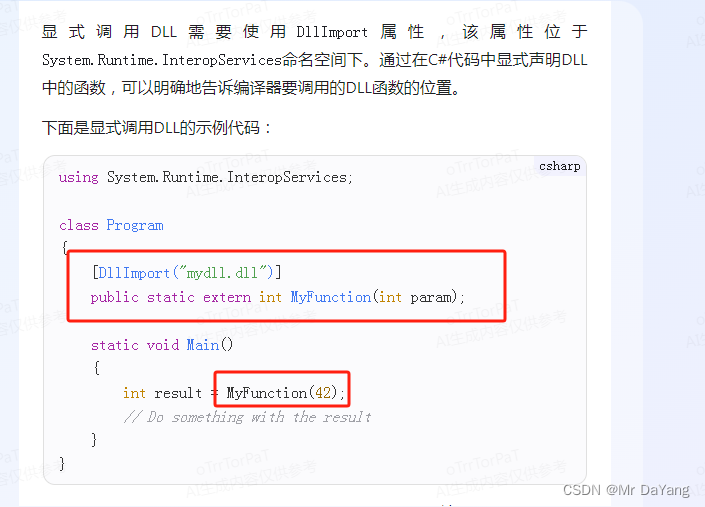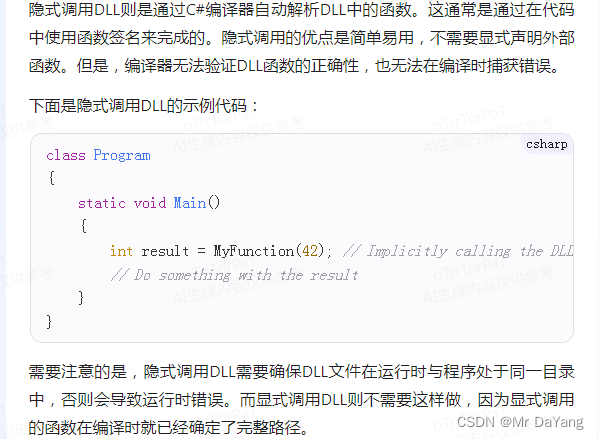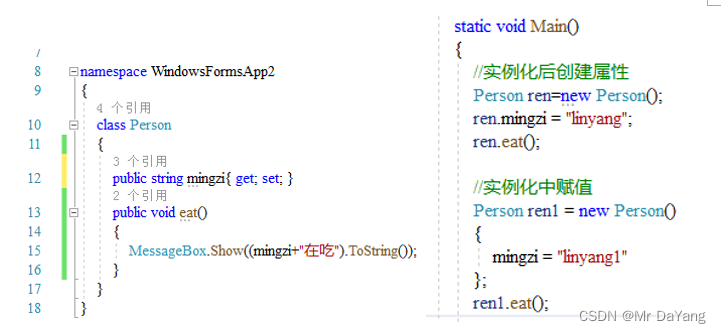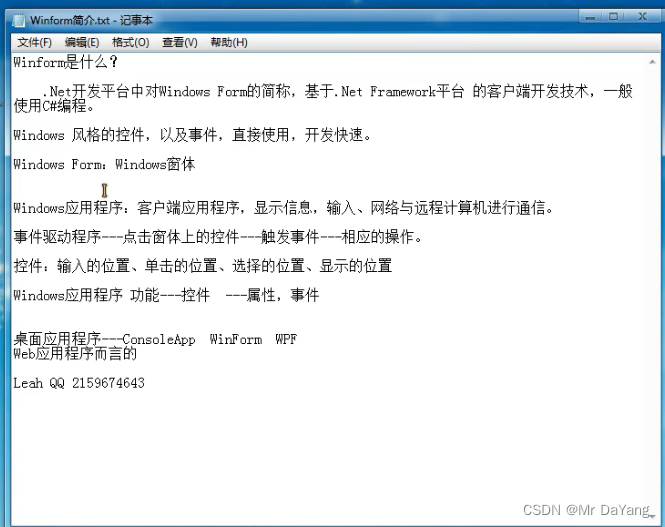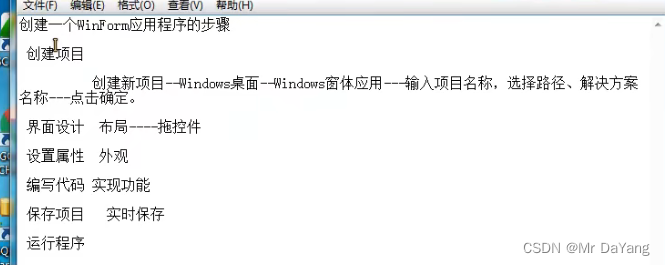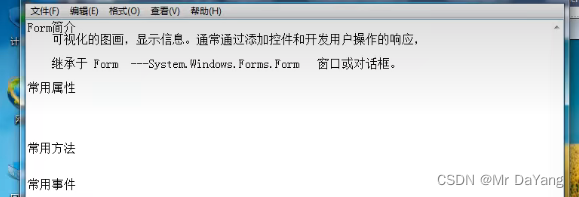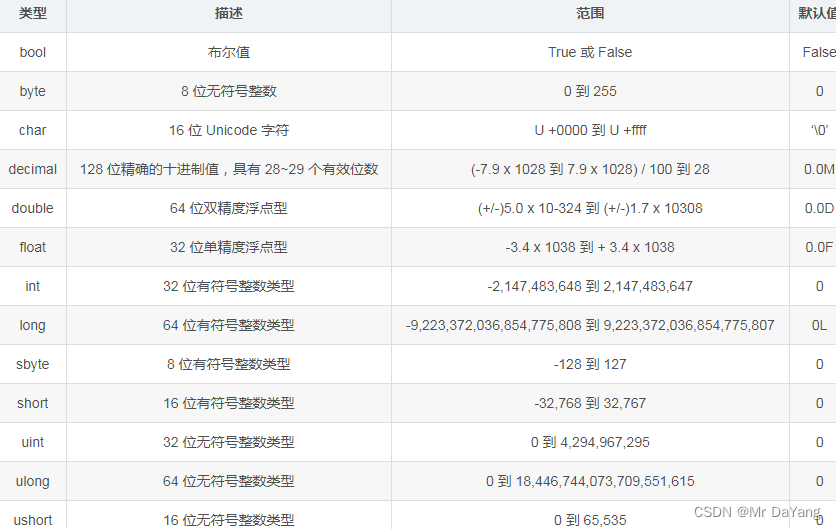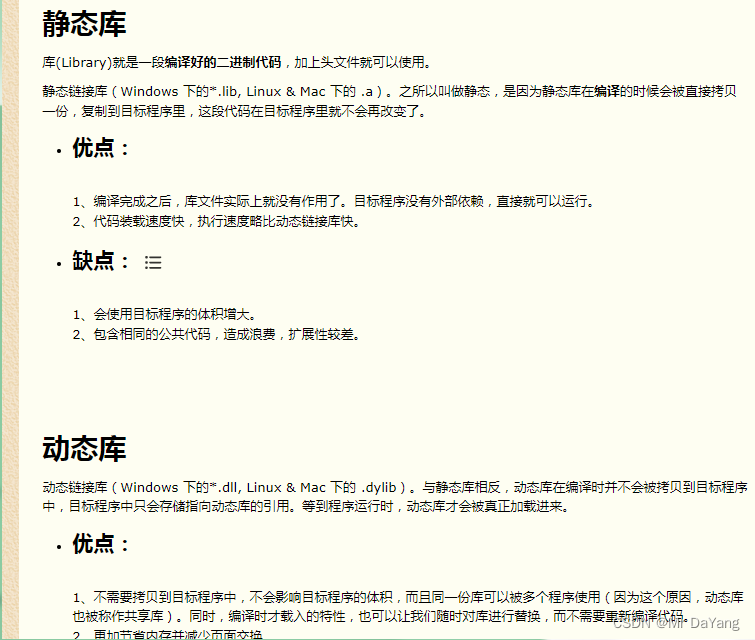C#基础知识点
目录
课程一、C#基础
1.C#编译环境、基础语法


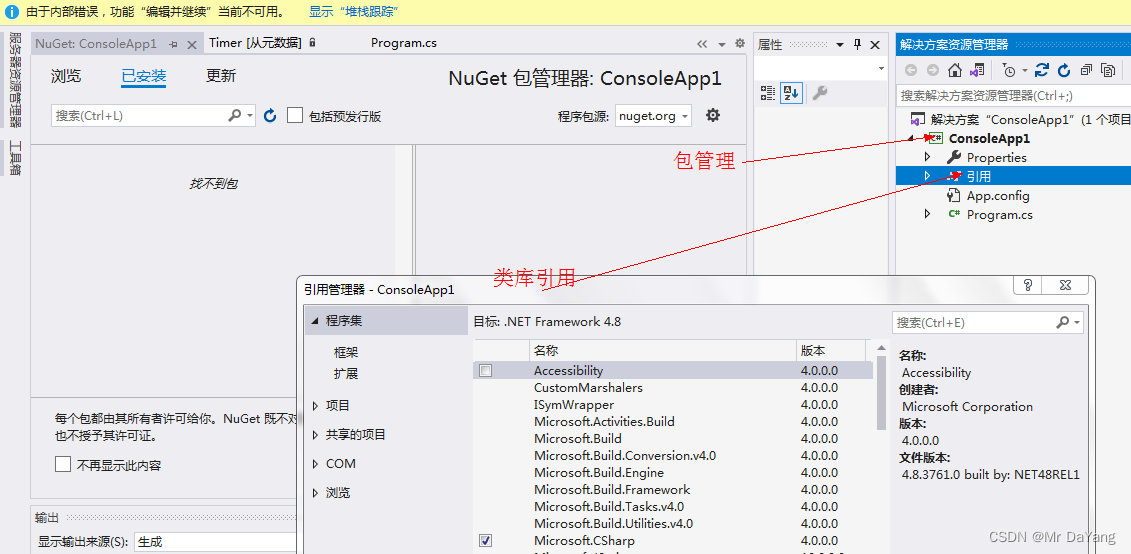
F12查看函数被引用的地方,ctrl +减号 返回
F10,debug时的一步步调试
alt+s左键 选几行中的某些字段
calculator.repoort() 加括号表示调用方法 calculator.repoort 表示方法名
1.查看变量类型
Debug.WriteLine(array3.GetType().ToString())
2.抛出异常
try
{
可能会出现异常的代码块;
}
//try和catch之间不能有其它的代码
catch
{
出现异常后要执行的代码块;
}
3.查看两变量或对象是否是一个值?
Console.WriteLine{"{0}",stu.GetHashCode()};
4.将文件中一个变量名统一修改成另外一个
对一个修改完后,按 ctrl+点 实现
5.类是典型的引用类型
6.Action action1 = new Action(stu1.dohomework); stu1.dohomework 是函数名
7.1.类中定义方法时,后面不用加; 只有执行的语句要加;2.stu1.dohomework()是方法的调用 stu1.dohomework 是函数名 public double Price { get; set; } Action action1 = new Action(stu1.dohomework); stu1.dohomework 是函数名
8.registerMonitor.get_Reg = get_reg_values; get_reg_values没有变量类型,没有括号表示方法,那么是委托
9.使用alt+enter对写的代码进行补充
10.//委托类型创建 为 order事件创建
public delegate void OrderEventHandler(Customer customer, OrderEventArgs e);
private OrderEventHandler orderEventHandler;//委托字段,用来存储事件处理器
11.一个类可以继承单个类,一个类可以有多个接口,一个接口也可以继承多个接口
12. new 创建的是静态类型,typeof 拿到的是动态描述
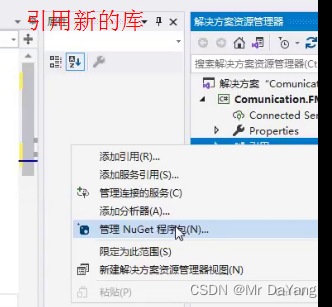
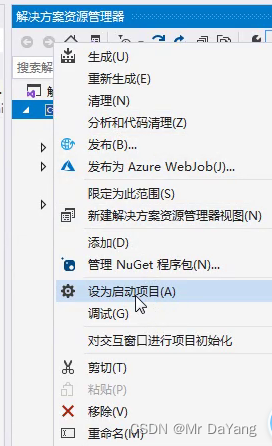
c# 了解
1.net 运行平台上,运行vb,c#,c++语言(.net环境为vb,c#,c++封装了各种工具包) .net core跨平台开发(可运行win linux) 相当于java开发工具包jdk上,包含java运行环境(jre,jvm+java系统类库)和java工具
2.c#工具 visual studio 2019
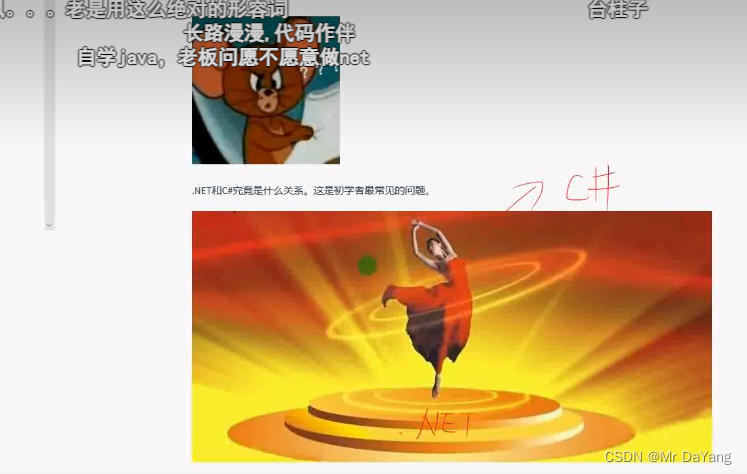
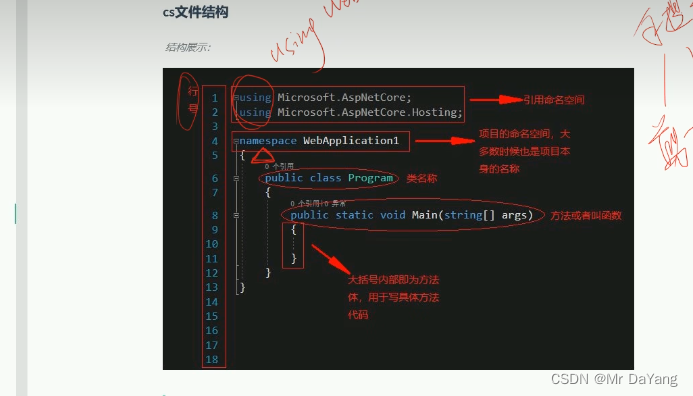
关键字声明 class类 namespace int(申明整数变量)
//单行注释
/* */多选注释
// 放到类、方法前按下///进行注释
变量为小数1.123,系统将其认为是double 型, float a=1.123报错 double a=1.123正确
string s='“” 与s=null 区别:“”“”的字符串为空, null直接就是空,存字符串的地方都没有,只有string才可以=null,其他类型变量不可以
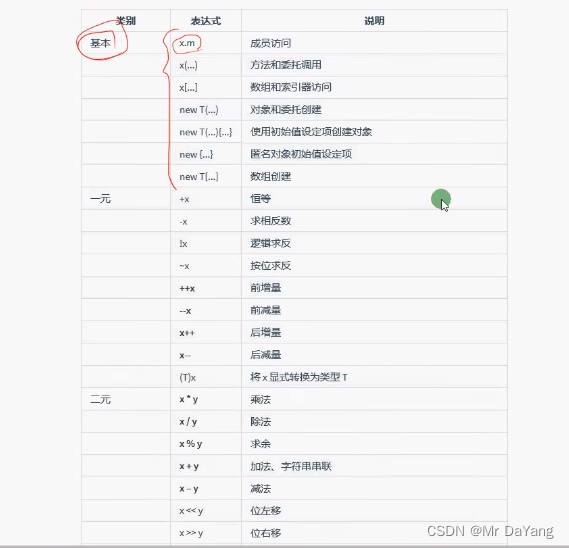
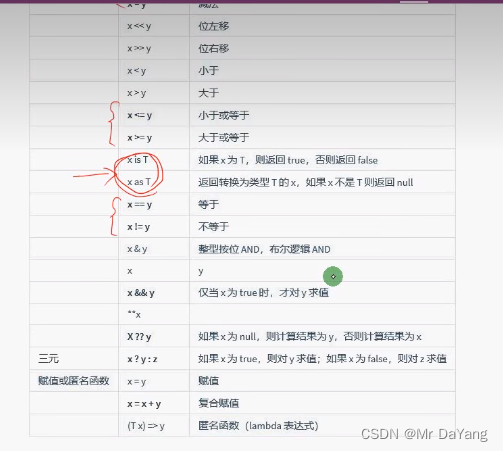
int x=2;
show(++x) ; x=3 前++先执行
show(x); x=3
string a=5;
show(a++); a=5 后++ 后执行
show(a); a=6
IF要一个个判断才能选择某个分支,switch直接进入那个分支

private void InitializeComponent()
{
MessageBox.Show("linyang");
int a = 2;
switch (a) //a可以为数字也可为string
{
case 1:
MessageBox.Show("1");
break;
case 2:
MessageBox.Show("2");
break;//必须要break
}
//for 循环直接循环 while 预设一个条件,当条件满足时进入循环, do {}while 先执行,达到条件退出
for (int a =2; a<4; a++)
{
MessageBox.Show(a.ToString());
};
int i = 1;
while (i <=3) {
MessageBox.Show((i++).ToString());
}
int b = 1;
do {
MessageBox.Show((b).ToString());
b++;
}
while (b < 4);
每次new就会开辟一个新地址,尽管内容一次,但不是同一个
//关键字 int,int[] 声明变量类型,new 创建数组
int q = 2;
int[] a = new int[6];
int[] b = new int[3] { 1,2,3};
int[] c = new int[] { 'a',2,3};
MessageBox.Show(c[0].ToString()); //输出97

/*无修饰时函数内部处理的是副本不影响原来的值
string want = "2222"; //want = "2222"
Sellhouse(want); //box显示1111
MessageBox.Show(want.ToString()); //box显示2222
*/
/*out修饰时,引用传递, 函数内部处理的是原地址,影响原来的值
string want = "2222"; //want = "2222"
Sellhouse1(out want); //box显示1111
MessageBox.Show(want.ToString()); //box显示1111
*/
/*ref修饰时,引用传递, 函数内部处理的是原地址,影响原来的值,与out不同,out使用函数中(Sellhouse1)必须要赋值否则报错
string want = "2222"; //want = "2222"
Sellhouse2(ref want); //box显示1111
MessageBox.Show(want.ToString()); //box显示1111
*/
}
public void Sellhouse(string want)
{
want = "1111";
MessageBox.Show(want.ToString());
}
public void Sellhouse1(out string want)
{
want = "1111"; //有out时必须要赋值,否则报错
MessageBox.Show(want.ToString());
}
public void Sellhouse2(ref string want)
{
want = "1111"; //有ref时,谁调用它必须赋初值,否则报错
MessageBox.Show(want.ToString());
}
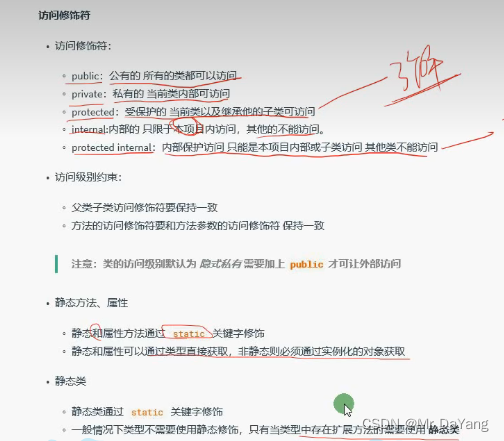
数组是连续的不能add,delete(new int[3])
集合(arraylist支持add,delete但是装箱拆箱耗时-由于存储变量类型不一致情况导致,
list泛型 list约束了只支持一种类型)
int[] a=new int[5]
Arraylist a=new Arraylist()

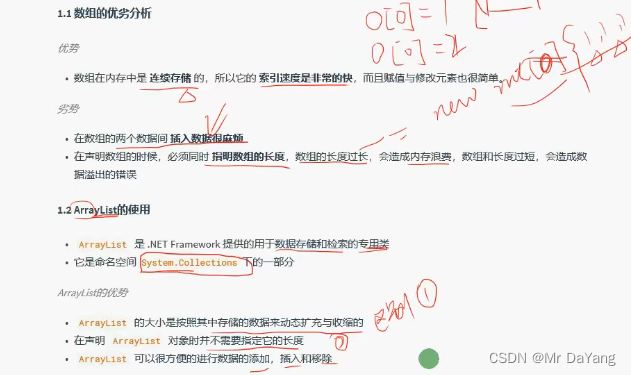

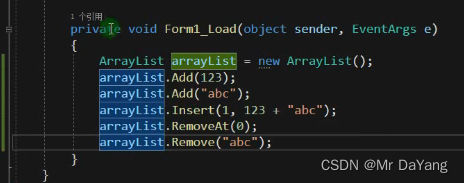

List<int> a = new List<int>( );
List<int> b = new List<int> { 1,2,2};
List<Person> p = new List<Person>();
a.Add(112);
a[0] = 4;
a.Insert(0, 3);
a.RemoveAt(0);
a.Remove(4);
a.Clear();
p.Add(new Person() { });
Dictionary<int, string> c = new Dictionary<int, string>();
Dictionary<int, string> d = new Dictionary<int, string> { //对象初始化器
{ 2,"333"},{4,"555"}
};
c.Add(1, "111");
c.Add(2, "222");
c.Add(3, "333");
string value = c[2];//通过键索引到值; “222”
bool f=c.Remove(1);//通过键删除那个值

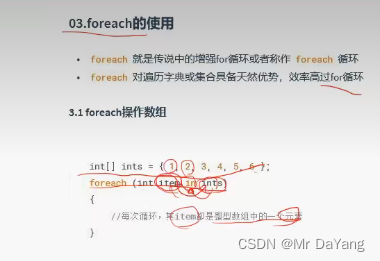
int[] a = new int[] { 3,4,5};
foreach (int i in a)
{
MessageBox.Show(i.ToString());
}
List<int> b = new List<int> { 2,3,4};
foreach(int i in b)
{
MessageBox.Show(i.ToString());
}
Dictionary<string, string> c = new Dictionary<string, string>() { {"aa","aaaaa" },{"bb","bbbb" } };
foreach (KeyValuePair<string,string> i in c)
{
string key = i.Key;
string value = i.Value;
}
2.Winform-后续未学完
课程二、Timothy C#底层讲解
一、类成员
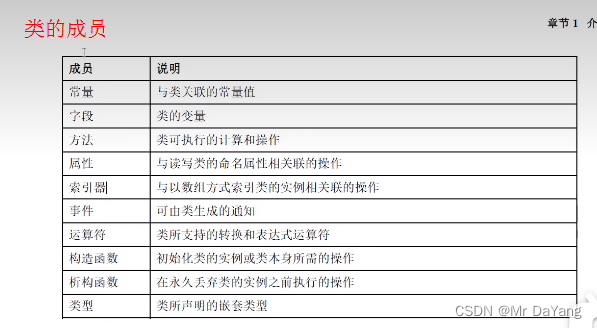
0常量
math.PI 就是常量 运算效率高,不用从内存中读
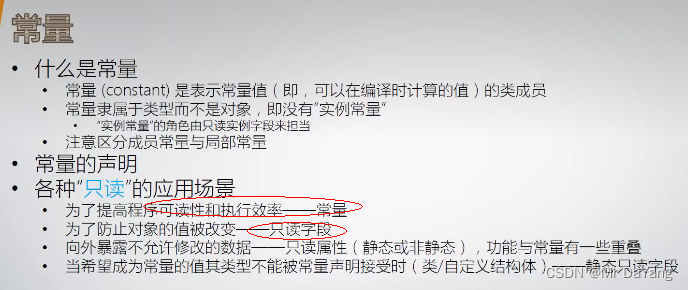
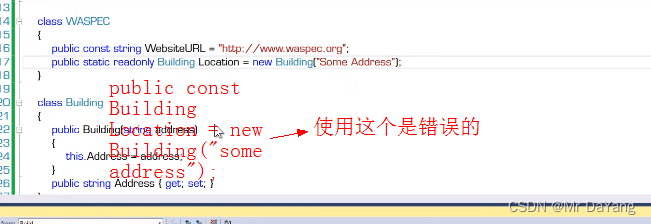
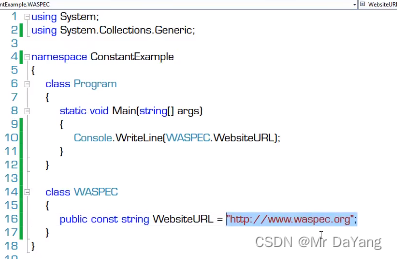
1字段
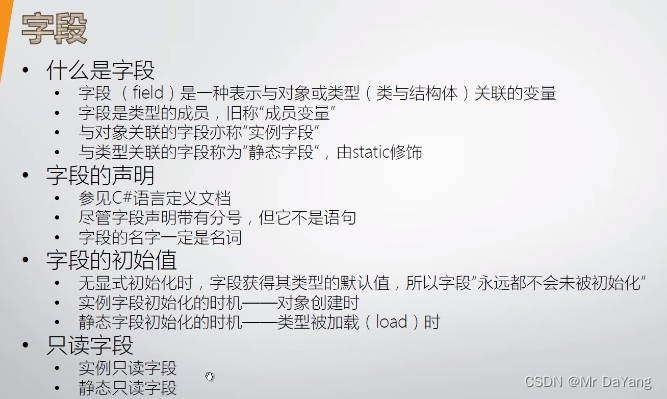
实例字段初始化时机:创建一个类时
静态字段初始化时机:这个程序被加载时,字段在声明时就初始化了,只初始化一次
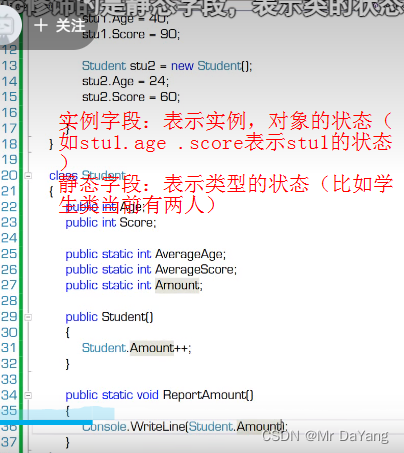
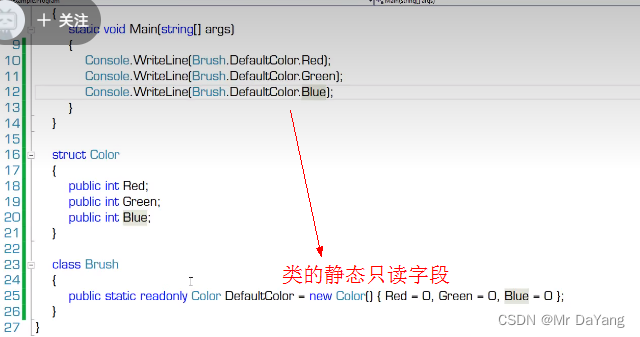
2属性(get、set决定属性私密性)
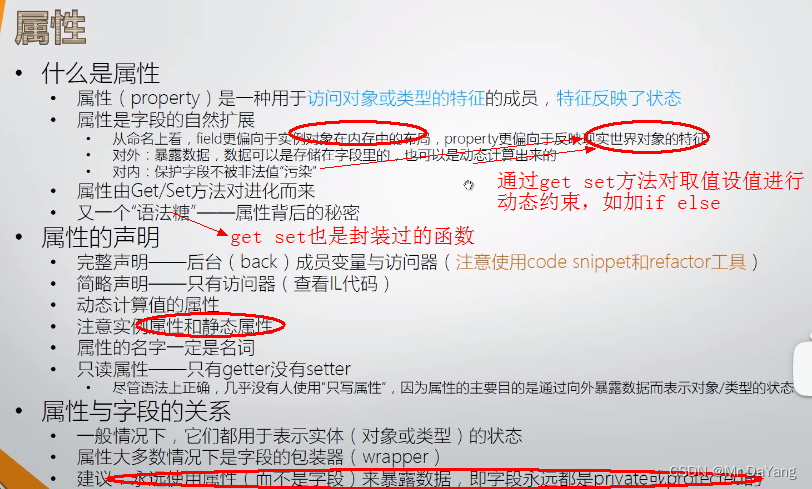
1属性完整申明
// 在类中输入 propfull按两下tab自动生成
class person
{
private int age;
public int Age
{
get { return age; }
set {
if (value >= 0 && value <= 120)//这个value是微软特定设置在set下的,不用申明
{
age = value;
}
else
{
throw new Exception("age value has error11111");
}
}
}
}
//使用,使用private后
person p1 = new person();
p1.Age=100;
2属性简易申明,对字段没有保护措施
// 在类中输入 prop按两下tab自动生成
class person
{
public int MyProperty { get; set; }
}
3字段int age->方法对 get() ->属性Age{get;set}的推演
using System;
using System.Collections.Generic;
using System.Linq;
using System.Text;
using System.Threading.Tasks;
namespace ConsoleApp1
{
class Program
{
static void Main(string[] args)
{
try
{
Student stu1 = new Student();
stu1.Age = 20;//使用private后,类调用属性只能get set方法
//stu1.Setage(20);
Student stu2 = new Student();
//stu2.Setage(20);
stu2.Age = 20;
Student stu3 = new Student();
//stu3.Setage(810);
stu3.Age = 210;
int avgage = (stu1.Age + stu2.Age + stu3.Age) / 3;
Console.WriteLine(avgage);
Console.Read();
}
catch(Exception ee)
{
Console.WriteLine(ee.Message);//"age value has error"打印到前台
Console.Read();
}
}
}
class Student
{
private int age;
public int Getage ()
{ return this.age;
}
public void Setage(int value)//属性可以对变量防护
{
if (value >= 0 && value <= 120) {
this.age = value;
}
else
{
throw new Exception("age value has error");
}
}
private int age;
public int Age
{
get { return this.age; }
set
{
if (value >= 0 && value <= 120)//这个value是微软特定设置在set下的,不用申明
{
this.age = value;
}
else
{
throw new Exception("age value has error11111");
}
}
}
}
}
3索引器
索引器用在集合中
//输入index 按两下TAB生成
using System;
using System.Collections.Generic;
using System.Linq;
using System.Text;
using System.Threading.Tasks;
namespace ConsoleApp1
{
class Program
{
static void Main(string[] args)
{
try
{
Student stu = new Student();
var mathscore = stu["Math"];
Console.WriteLine(mathscore==null);
Console.Read();
}
catch(Exception ee)
{
Console.WriteLine(ee.Message);//"age value has error"打印到前台
Console.Read();
}
}
}
class Student
{
private Dictionary<string, int> score = new Dictionary<string, int>();
public int? this[string subject] //int?可空int型号 subject自己定义的成绩科目名为subject
{
get {
if (this.score.ContainsKey(subject))
{
return this.score[subject];
}
else
{
return null;
}
}
set { /* set the specified index to value here */
if (value.HasValue == false)
{
throw new Exception("score cannot be null");
}
if (this.score.ContainsKey(subject))
{
this.score[subject]=value.Value;//int?可空int型号
}
else
{
this.score.Add(subject, value.Value);
}
}
}
}
}
5方法
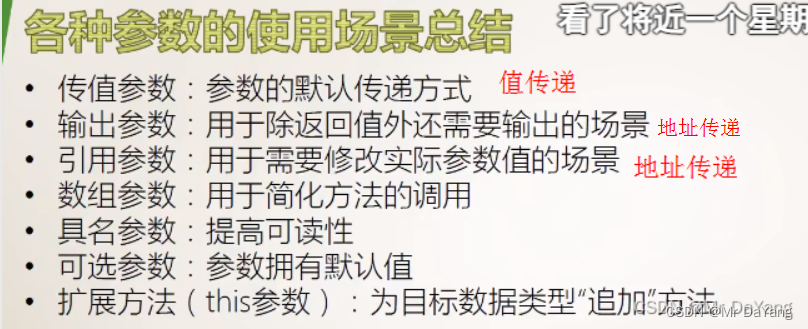
5.1值参数(创建副本,方法内对值的操作,不会影响原来变量的值)
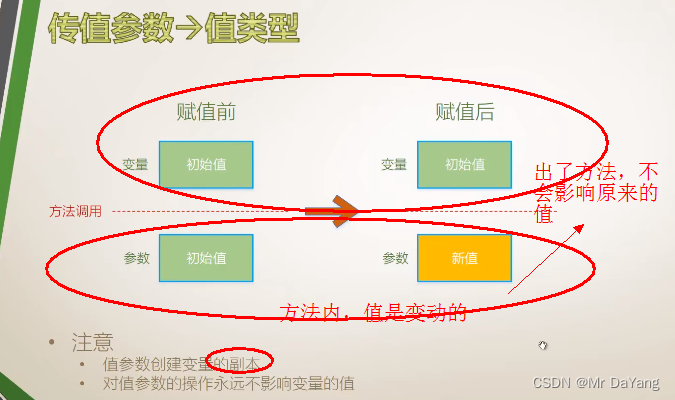
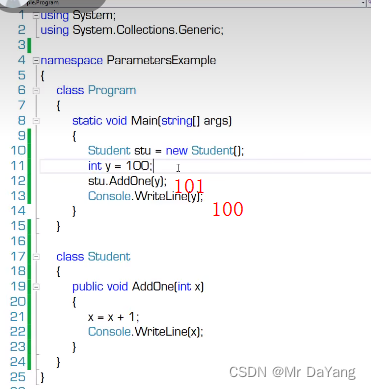
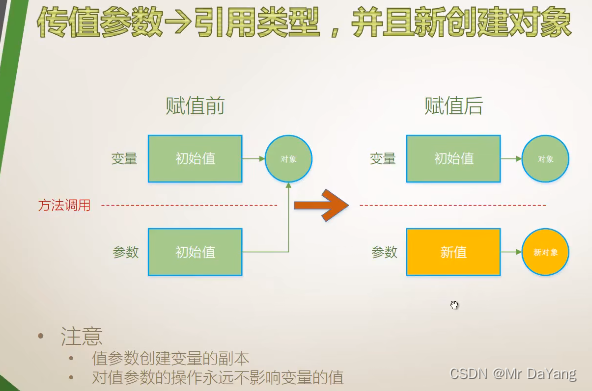

引用类型,不创建新对象
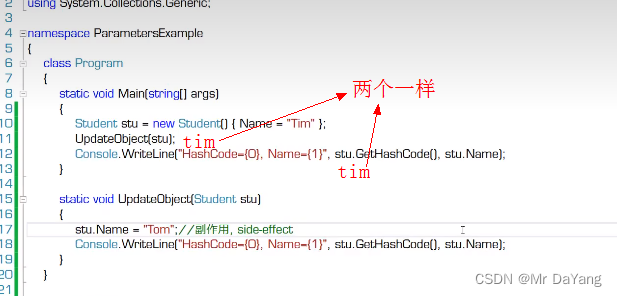
5.2引用参数(传的是地址,方法内对值的操作,出了方法后原来的值也被修改)
引用参数在传入方法前必须有个明确的赋值,然后在方法中修改
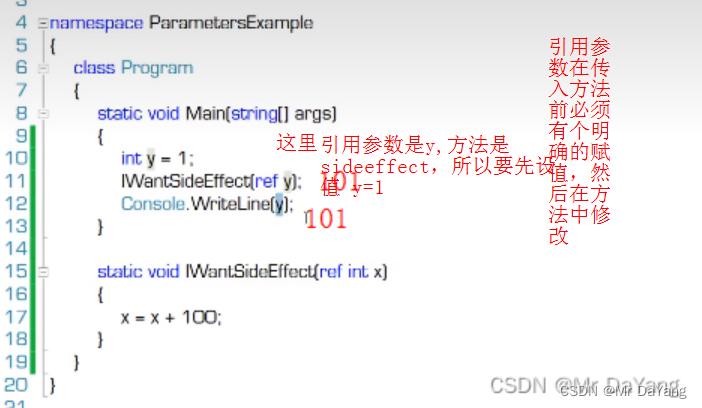
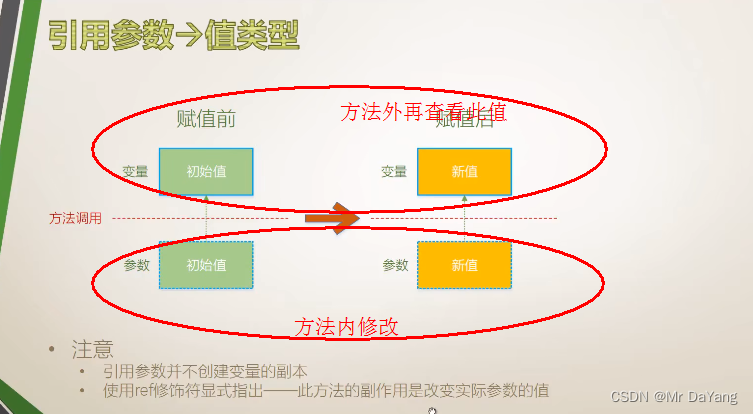
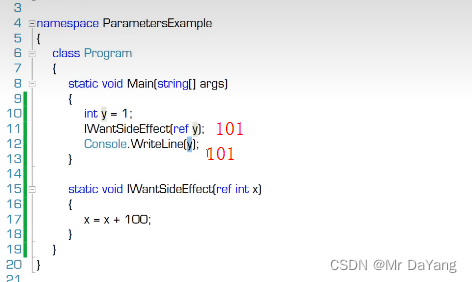
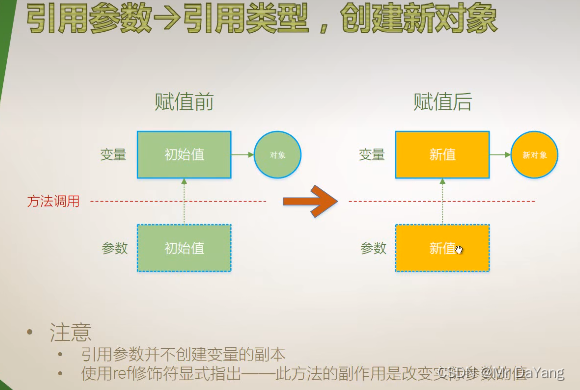
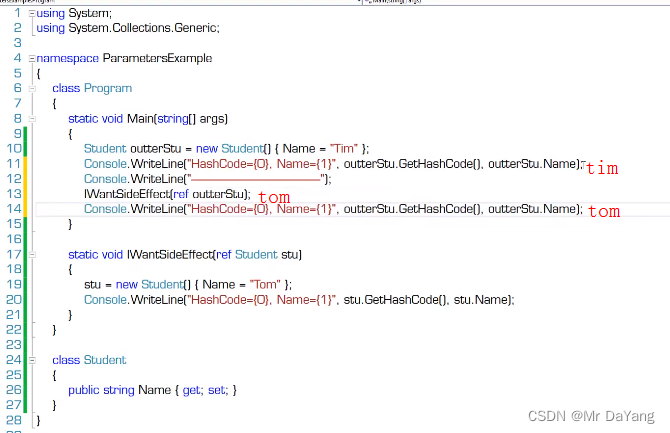
5.3 输出参数(普通方法一次调用只产出一个返回值,但希望一次调用返回多个输出值,所以用输出参数)
讲解的时值先讲值 引用变化,再讲类引用变化
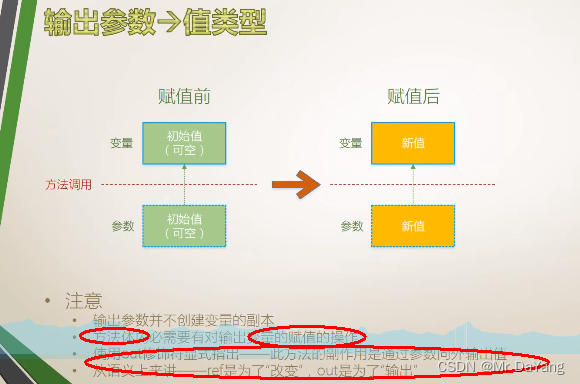
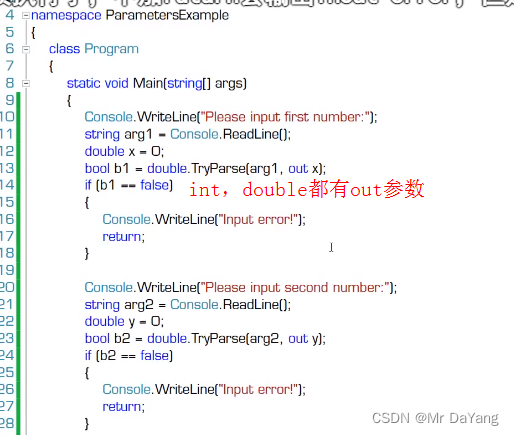
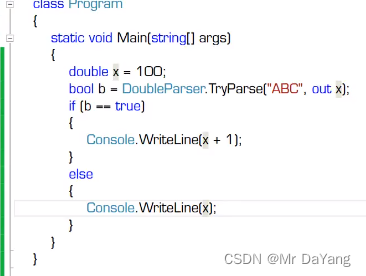
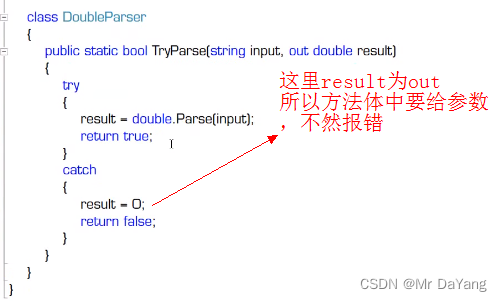
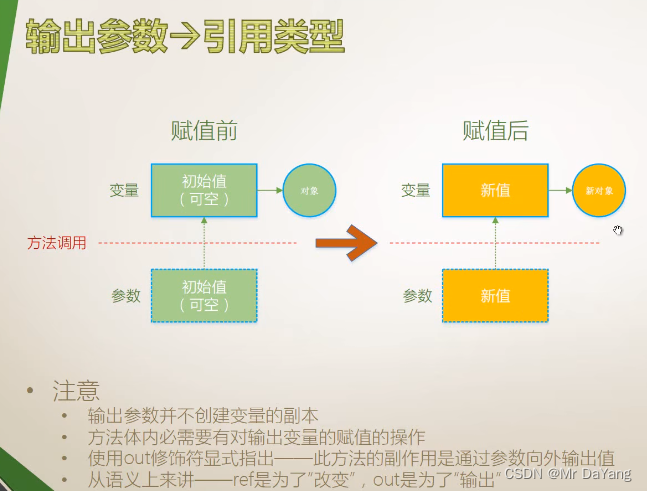
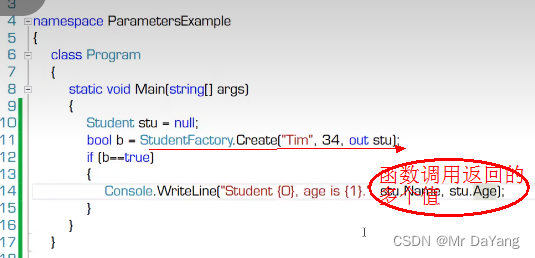
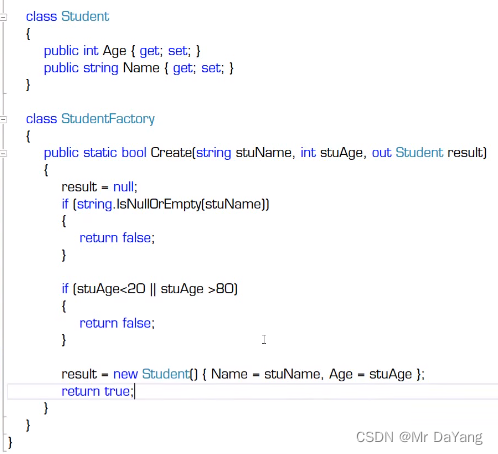
5.4 数组参数 parmas(可供函数输出多个值)




5.5 具名参数(调用方法时,参数带有名字,位置随意)

5.6 可选参数(方法定义声明时,有默认值)


5.7 扩展方法(this参数)


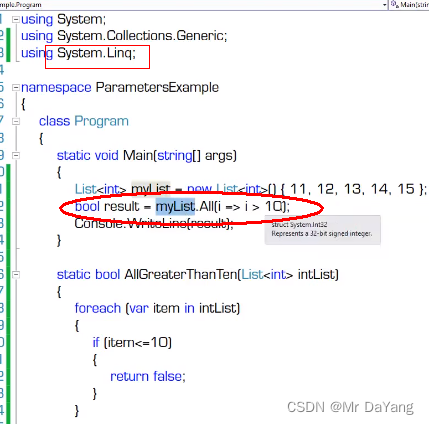
二、委托
一、理解委托
那么函数能作为形参吗?答案是可以的,当函数作为形参时,此函数就称为回调函数。在C#中使用了一种更方便的方式——委托,使函数作为形参更方便。
可以将委托看成一种模具,凡是能够完全匹配此模具的函数都可以放进此模具中当成参数或变量来使用。
二. 委托的使用
1. 委托的使用过程:
1)定义委托类型;
定义委托时使用关键字delegate,如:
public delegate void Del(int a,int b); 此委托就定义了一种返回值是void,特征标是(int,int)的函数引用类型;
2)创建此委托类型的对象,将方法绑定到此委托上;
如果定义变量 Del function=new Del(Add),
3)通过委托调用方法;
那么function(1,2)就相当于调用了Add(1,2);
二、委托与事件
将委托封装成事件来实现可靠的发布订阅。
具体做法是在委托类型前添加关键字event来定义此委托的事件,如:
public event Del EventDel; 就将委托类型Del封装成了事件EventDel;
此时可以使用将函数订阅到事件上,当激发事件时就会调用此事件所订阅的函数,如:
EventDel+=Add1;
EventDel+=Add2;
EventDel+=Add3;
则EventDel(1,2)就会依次调用函数Add1、Add2和Add3。
1委托(c# Action,Func常规委托)
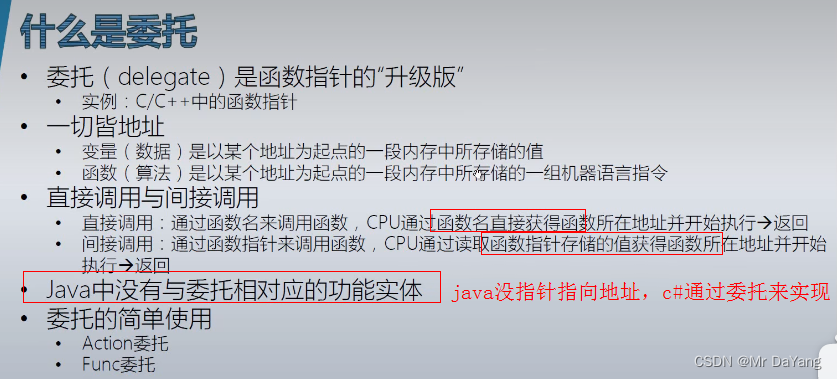
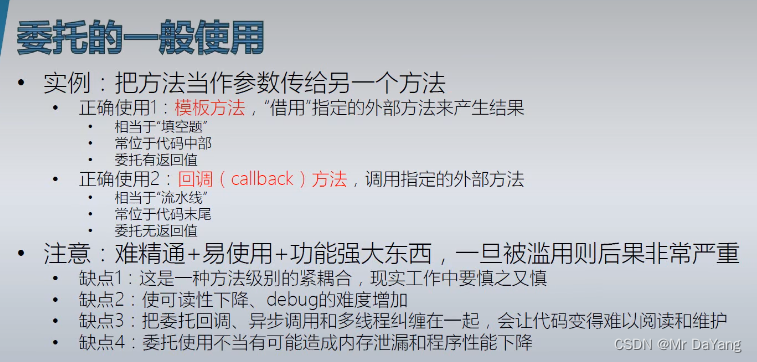
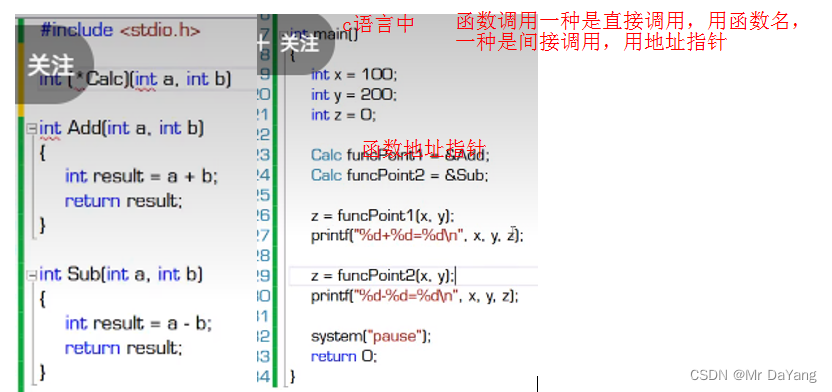
using System;
using System.Collections.Generic;
using System.Linq;
using System.Text;
using System.Threading.Tasks;
namespace ConsoleApp1
{
class Program
{
static void Main(string[] args)
{
Calculator calculator = new Calculator();
Action action = new Action(calculator.Report);//Action: 方法是void,并且无参数
action.Invoke();//委托调用
action();//模仿c中函数指针的书写格式
calculator.Report();//直接调用方法名
//<第一个int为返回值, 第二三个int为函数输入>
Func<int, int, int> func1 = new Func<int, int, int>(calculator.Add);//Func :方法是有返回,有参数
Func<int, int, int> func2 = new Func<int, int, int>(calculator.Sub);
int x = 100;
int y = 200;
int z = 0;
z = func1.Invoke(x, y);//委托调用
Console.WriteLine(z);
z = func2.Invoke(x, y);
Console.WriteLine(z);
func1(x, y);//模仿c中函数指针的书写格式
}
}
class Calculator
{
public void Report() {
Console.WriteLine("i have 3 methods");
}
public int Add(int a,int b)
{
int result = a + b;
return result;
}
public int Sub(int a, int b)
{
int result = a - b;
return result;
}
}
}
2委托声明 (delegate自定义委托)
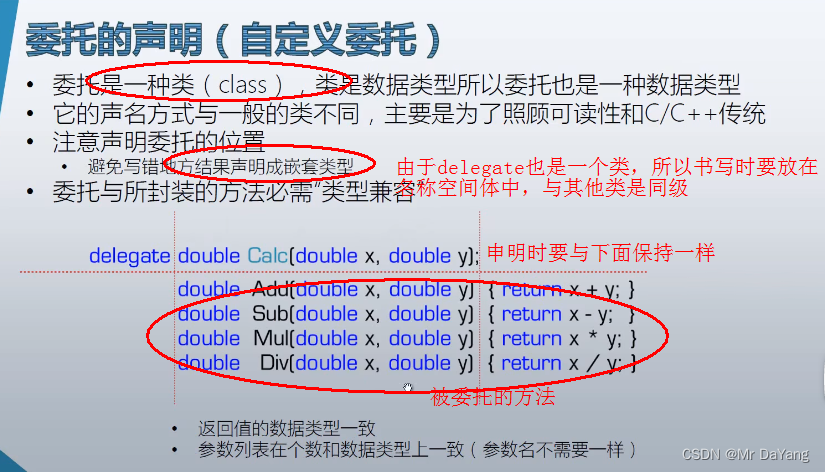
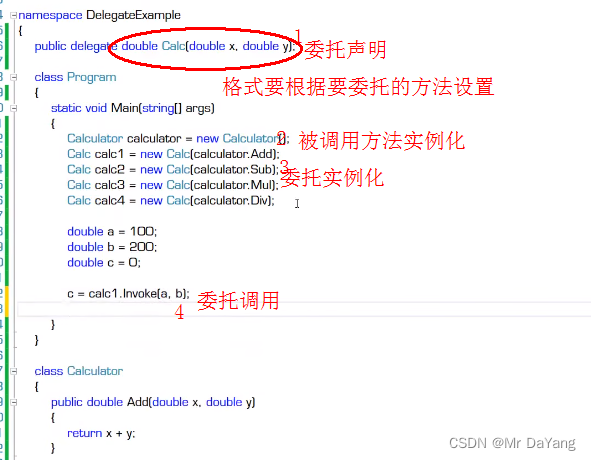
3委托使用(把方法当做参数会给另一个方法:模板法,回调法)
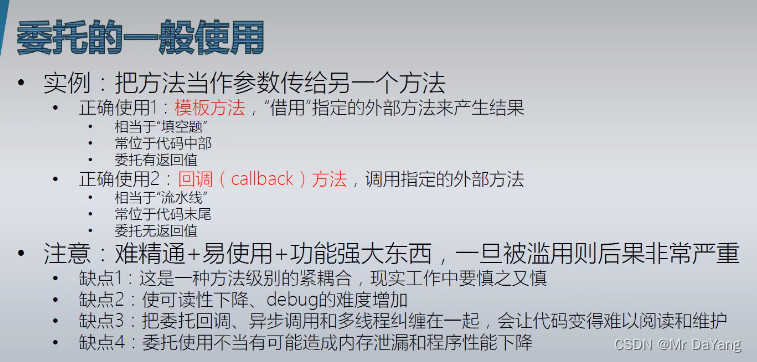
实现目的:方法中调用方法
现实中是无法操作的,所以采用模板方法+用委托类型参数封装的方法的方式来实现,委托相当于一个指针,可以指定任意方法,就可以实现方法调方法。
模板方法:方法中 输入 用委托类型参数封装的方法
回调方法:方法中 在调用 用委托类型参数封装的方法 时,有条件判断
using System;
using System.Collections.Generic;
using System.Linq;
using System.Text;
using System.Threading.Tasks;
namespace ConsoleApp1
{
class Program
{
static void Main(string[] args)
{
ProdectFactory prodectFactory = new ProdectFactory();
WrapFactory wrapFactory = new WrapFactory();
//<第一个int为返回值, 第二三个int为函数输入>
// Func<int, int, int> func1 = new Func<int, int, int>(calculator.Add);//Func :方法是有返回,有参数
//1委托封装方法
//Product为委托的返回类型 ,func1为委托名 =new委托的返回值类型是Product,委托的函数名称=prodectFactory.MakePiza
Func<Product> func1 = new Func<Product>(prodectFactory.MakePiza);
Func<Product> func2 = new Func<Product>(prodectFactory.Makecar);
Logger logger = new Logger();
Action<Product> log = new Action<Product>(logger.Log);
//2调用模板方法,返回值为box1
Box box1=wrapFactory.WrapProduct(func1,log);
Box box2 = wrapFactory.WrapProduct(func2,log);
Console.WriteLine(box1.product.Name);
Console.WriteLine(box2.product.Name);
Console.Read();
}
class Logger
{
public void Log(Product product)
{
Console.WriteLine("Product '{0}' created at {1},price is {2}", product.Name, DateTime.UtcNow, product.Price);
}
}
class Product
{
public string Name { get; set; } //类属性是string
public double Price { get; set; }
}
class Box
{
public Product product { get; set; }//类属性是一个类
}
class WrapFactory
{
//WrapProduct 委托的模板方法,Box方法的返回值
//委托模板方法的输入是委托函数 Func<Product> getProduct
public Box WrapProduct(Func<Product> getProduct, Action<Product> logCallback)
{
Box box = new Box();
Product product = getProduct.Invoke();
if (product.Price > 50)
{
logCallback(product);
}
box.product=product;
return box;
}
}
class ProdectFactory
{
public Product MakePiza()
{
Product product = new Product();
product.Name = "Pizza";
product.Price = 12;
return product;
}
public Product Makecar()
{
Product product = new Product();
product.Name = "car";
product.Price = 100;
return product;
}
}
}
}
4委托高级使用(多播委托\异步委托调用)
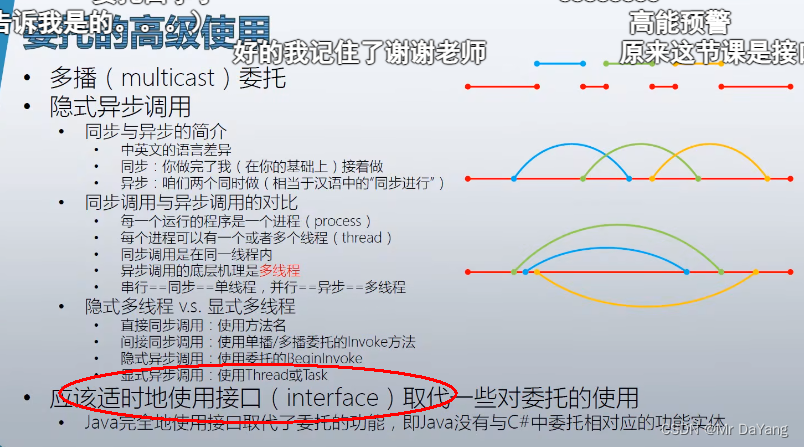
using System;
using System.Collections.Generic;
using System.Linq;
using System.Text;
using System.Threading;
using System.Threading.Tasks;
namespace ConsoleApp1
{
class Program
{
static void Main(string[] args)
{
Student stu1 = new Student() { id = 1, pencolor = ConsoleColor.Yellow };
Student stu2 = new Student() { id = 2, pencolor = ConsoleColor.Green };
Student stu3 = new Student() { id = 3, pencolor = ConsoleColor.Red };
/* 1.同步间接调用-使用委托
Action action1 = new Action(stu1.dohomework);
Action action2 = new Action(stu2.dohomework);
Action action3 = new Action(stu3.dohomework);
//action1.Invoke();//单播委托
// action2.Invoke();
//action3.Invoke();
//多播委托
action1 += action2;
action1 += action3;
action1.Invoke();*/
//------------------------------------------------------------
/*
// 2同步直接调用
stu1.dohomework();
stu2.dohomework();
stu3.dohomework();
//------------------------------------------------------------
// 3隐式异步调用
Action action1 = new Action(stu1.dohomework);
Action action2 = new Action(stu2.dohomework);
Action action3 = new Action(stu3.dohomework);
action1.BeginInvoke(null, null);//第一个null为执行完线程后的回调函数
action2.BeginInvoke(null, null);
action3.BeginInvoke(null, null);
//------------------------------------------------------------
// 4显式异步调用
Thread thread1 = new Thread(new ThreadStart(stu1.dohomework));
Thread thread2 = new Thread(new ThreadStart(stu2.dohomework));
Thread thread3 = new Thread(new ThreadStart(stu3.dohomework));
thread1.Start();
thread2.Start();
thread3.Start();*/
// 4显式异步调用
Task task1 = new Task(new Action(stu1.dohomework));
Task task2 = new Task(new Action(stu2.dohomework));
Task task3 = new Task(new Action(stu3.dohomework));
task1.Start();
task1.Start();
task1.Start();
for (int i=0; i < 5; i++)
{
Console.ForegroundColor = ConsoleColor.Cyan;
Console.WriteLine("main thread{0}", i);
Thread.Sleep(1000);
Console.Read();
}
}
class Student
{
public int id { get; set; }
public ConsoleColor pencolor { get; set; }
public void dohomework()
{
for (int i =0; i <5;i++) {
Console.ForegroundColor = this.pencolor;
Console.WriteLine("student{0} doing homework {1} hours", this.id, i);
Thread.Sleep(1000);
}
}
}
}
}
二、委托v2
三、事件
1事件定义
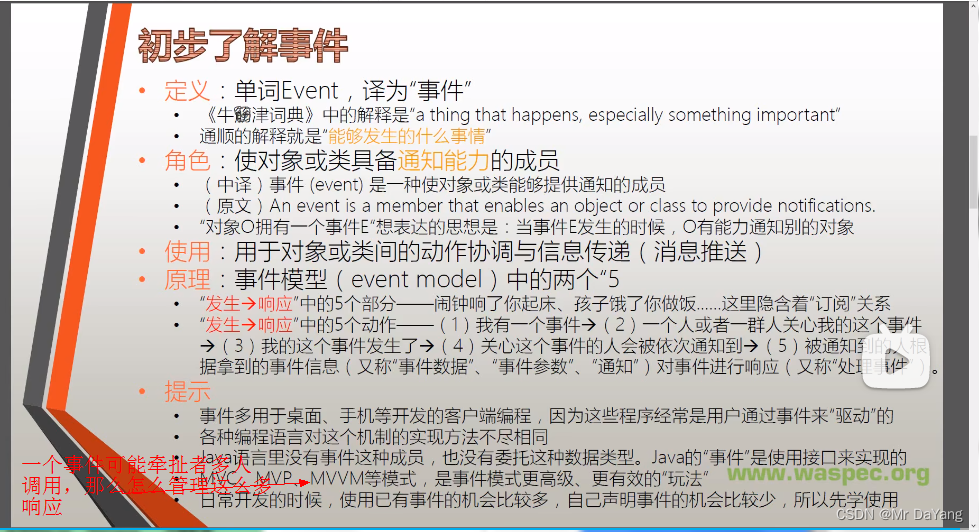
一个对象有事件,对象通过事件的发生来通知其他对象
程序员自己写的代码 订阅一个按钮,当按钮点击事件由客户触发时,那么代码就会对其进行响应。
用户操作下鼠标,就会执行一块程序,鼠标不用,那么这块程序就不执行。称这块程序为事件驱动程序。

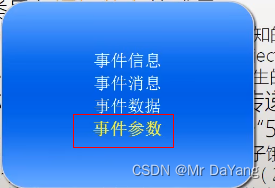
2事件应用(5要素)
事件的拥有者决定事件是否发生
按钮的内部逻辑(按下松开),触发了自己的click事件,
click事件发生了就会告知相应的订阅者,
相应的订阅者就会产生相应的行为。
这个约定就是委托,事件建立在委托上
事件与响应方法是可以1对多,多对1
订阅的挂接方式
this.button.click+=this.buttoonclicked;
this.button.click+=new EventHandler(this.buttoonclicked);
this.button.click+=(object sender, EventArgs e)=>{ this.textBox.text='hah';}; //流行
this.button.click+=delegate(object sender, EventArgs e){ this.textBox.text='hah';}//匿名方法过时
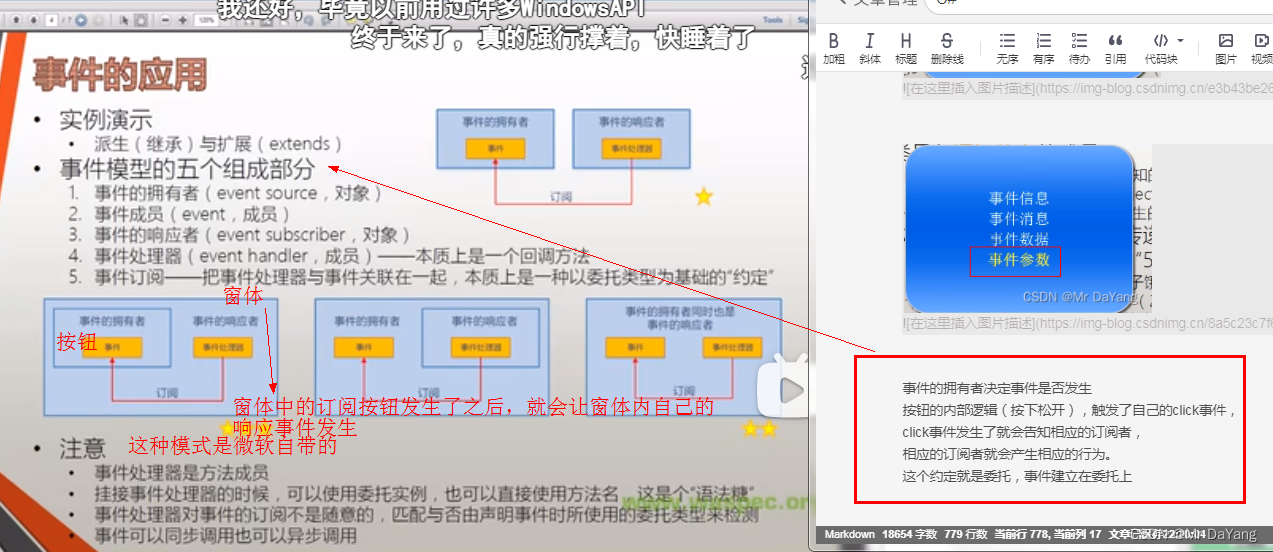
事件与响应方法是可以1对多,多对1
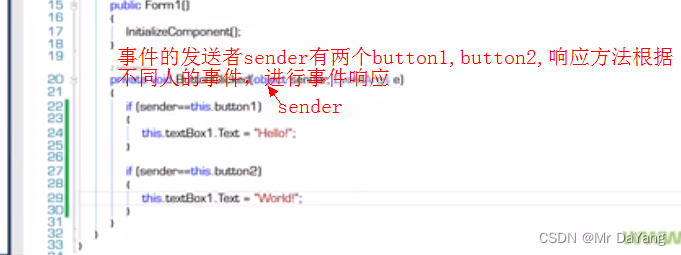
//一星展示
using System;
using System.Collections.Generic;
using System.Linq;
using System.Text;
using System.Threading.Tasks;
using System.Timers;
namespace ConsoleApp1
{
class Program
{
static void Main(string[] args)
{
Timer timer = new Timer(); // timer.Elapsed事件的拥有者Timer
timer.Interval = 1000;
Boy boy = new Boy(); //事件的订阅者
Girl girl = new Girl();
// 订阅者的处理器 +=表示订阅 拿方法订阅一个事件时,它们要遵守约定:约定就是委托类型
// timer.Elapsed的类型就是 public delegate void ElapsedEventHandler(object sender, ElapsedEventArgs e);
// 所以使用alt+enter自动按照委托形式对boy.Action进行方法创建
timer.Elapsed += boy.Action; //timer.Elapsed 为事件,boy.Action为事件处理器
timer.Elapsed += girl.Action; //一个事件两个订阅者
timer.Start();
Console.ReadLine();
}
class Boy
{
internal void Action(object sender, ElapsedEventArgs e)
{
Console.WriteLine("Jump");
}
}
class Girl
{
internal void Action(object sender, ElapsedEventArgs e)
{
Console.WriteLine("sing");
}
}
}
}
//三星展示
using System;
using System.Collections.Generic;
using System.Linq;
using System.Text;
using System.Threading.Tasks;
using System.Timers;
using System.Windows.Forms;
namespace ConsoleApp1
{
class Program
{
static void Main(string[] args)
{
Form form=new Form();//事件的拥有者
Controller controller = new Controller(form);//事件的响应者
form.ShowDialog();
}
class Controller
{
private Form form;
public Controller(Form form)
{
if (form != null)
{
this.form = form;
this.form.Click += this.Formclicked;//约定
}
}
private void Formclicked(object sender, EventArgs e)
{
this.form.Text = DateTime.Now.ToString();
}
}
}
}
//自己调自己,两星事件
using System;
using System.Collections.Generic;
using System.Linq;
using System.Text;
using System.Threading.Tasks;
using System.Timers;
using System.Windows.Forms;
namespace ConsoleApp1
{
class Program
{
static void Main(string[] args)
{
Myform myform = new Myform();
myform.Click += myform.Formclicked;
myform.ShowDialog();
}
class Myform : Form
{
internal void Formclicked(object sender, EventArgs e)
{
this.Text = DateTime.Now.ToString();
}
}
}
}
//三星:事件的拥有者是响应者的成员
using System;
using System.Collections.Generic;
using System.Linq;
using System.Text;
using System.Threading.Tasks;
using System.Timers;
using System.Windows.Forms;
namespace ConsoleApp1
{
class Program
{
static void Main(string[] args)
{
Myform myform = new Myform();
myform.ShowDialog();
}
}
class Myform : Form
{
private TextBox textBox;
private Button button;//form的字段成员,拥有者
public Myform()
{
this.textBox = new TextBox();
this.button = new Button();
this.Controls.Add(this.button);
this.Controls.Add(this.textBox);
this.button.Click += this.buttonCllicked; //form =响应者
this.button.Text = "sss";
}
private void buttonCllicked(object sender, EventArgs e)
{
this.textBox.Text = "hello world```````````````````````````";
}
}
}
3事件自定义
委托是事件的底层基础,事件是委托的上层建筑
//第三种
using System;
using System.Collections.Generic;
using System.Linq;
using System.Text;
using System.Threading;
using System.Threading.Tasks;
using System.Timers;
using System.Windows.Forms;
namespace ConsoleApp1
{
class Program
{
static void Main(string[] args)
{
Customer customer = new Customer(); //1事件拥有者
Waiter waiter = new Waiter();//2事件的响应者
customer.Order += waiter.Action;//事件 , 事件处理器 事件拥有者的内部逻辑触发了事件
customer.Action();//事件触发
customer.Paybill();
}
}
//事件的信息
public class OrderEventArgs:EventArgs
{
public string Dishname { get; set; }
public string Size { get; set; }
}
//委托类型创建 为 order事件创建
public delegate void OrderEventHandler(Customer customer, OrderEventArgs e);
public class Customer //1事件拥有者
{
private OrderEventHandler orderEventHandler;//委托字段,用来存储事件处理器
public event OrderEventHandler Order //2事件
{
add
{
this.orderEventHandler += value;
}
remove
{
this.orderEventHandler -= value;
}
}
public double Bill { get; set; }
public void Paybill ()
{
Console.WriteLine("i will pay ¥{0}", this.Bill);
}
public void Walk()
{
Console.WriteLine("walk into restaurant");
}
public void Sitdown()
{
Console.WriteLine("Sitdown");
}
public void Think()//事件触发
{
for (int i=0; i < 5; i++)
{
Console.WriteLine("let me thikn''''");
Thread.Sleep(1000);
}
if (this.orderEventHandler != null)//如果没人订阅这个事件,事件发生时会报错
{
OrderEventArgs e = new OrderEventArgs();
e.Dishname = "KONGBAO JIDING";
e.Size = "large";
this.orderEventHandler.Invoke(this, e);
}
}
public void Action()
{
Console.ReadLine();
this.Walk();
this.Sitdown();
this.Think();
}
}
public class Waiter
{
public void Action(Customer customer, OrderEventArgs e)
{
Console.WriteLine("i will serve you dish {0}", e.Dishname);
double price = 10;
switch (e.Size)
{
case "small":
price = price * 0.5;
break;
case "large":
price = price * 2;
break;
default:
break;
}
customer.Bill += price;
}
}
}
四、类
1构造器、析构器
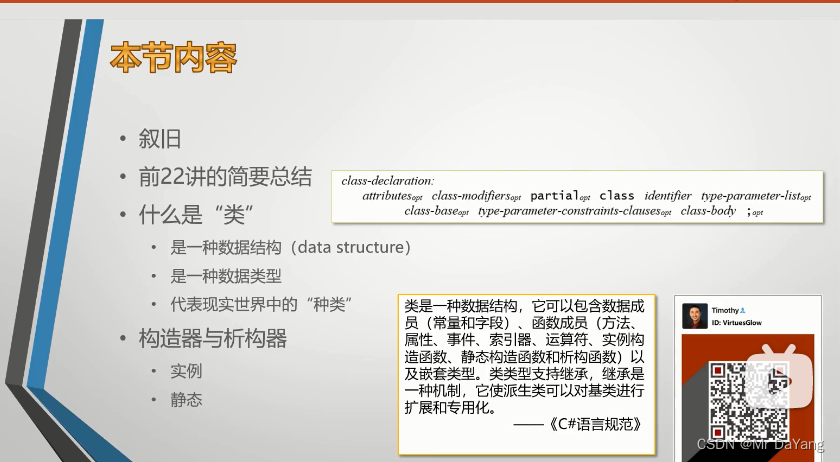
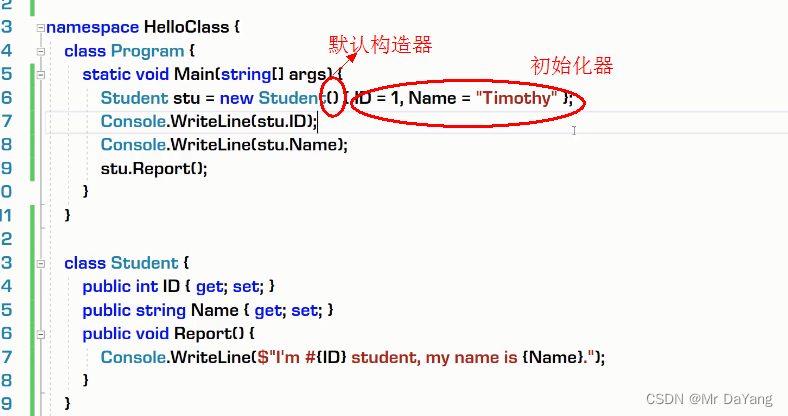
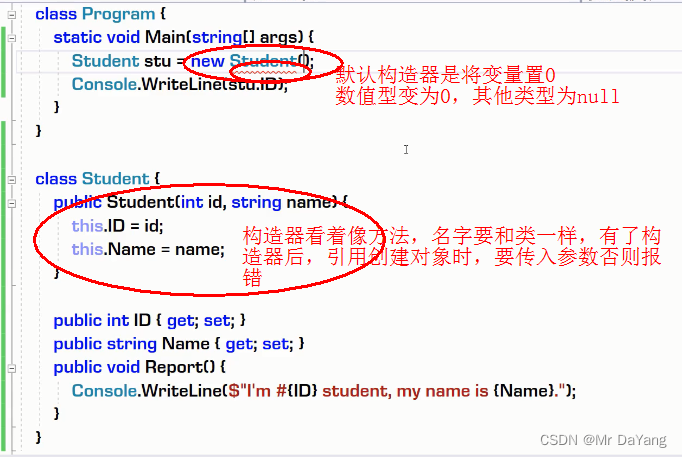
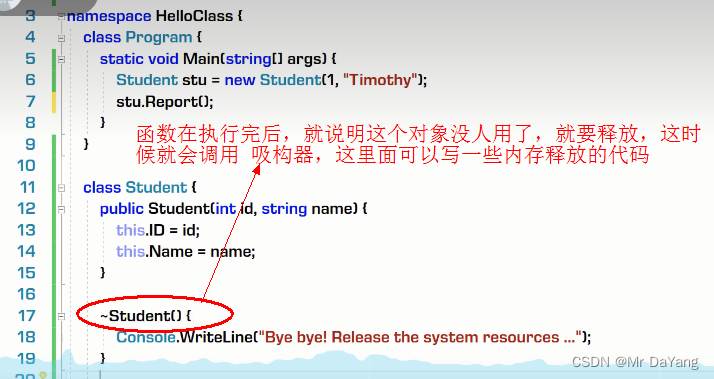
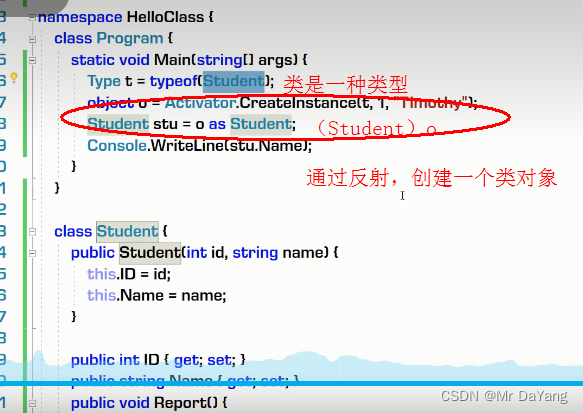
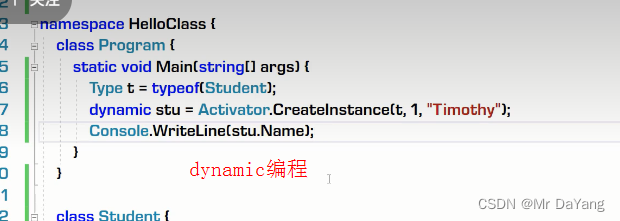
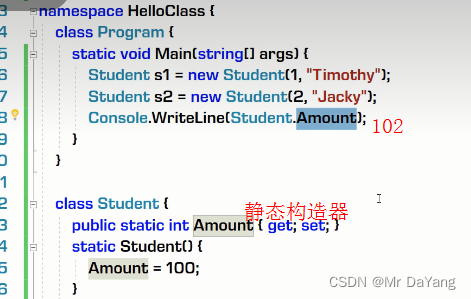

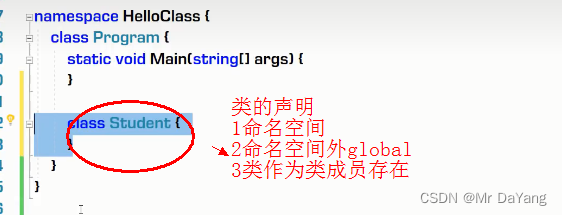
2.类修饰符(public\internal\abstract)
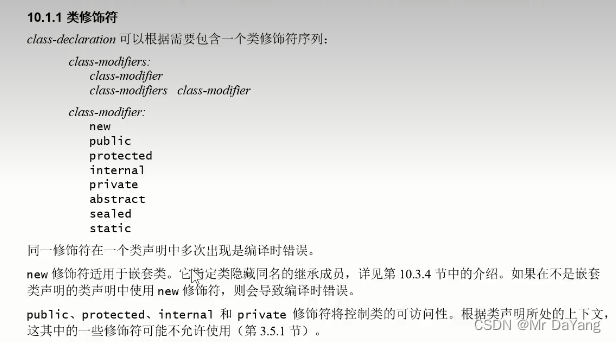

类的继承
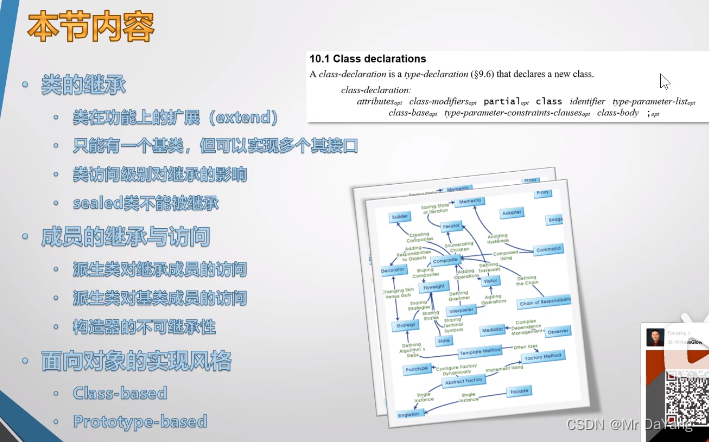

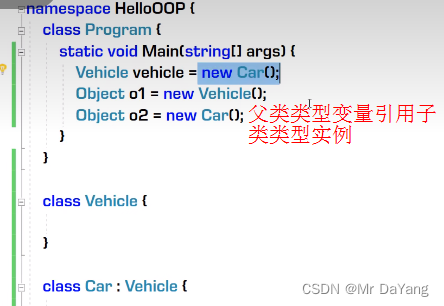
sealed修饰类后,这个类不能被当成基类使用
一个类只能有一个基类
子类的类访问级别不能超越基类
横向扩展对类成员的扩充,纵向扩展对类成员的重写
子类是对父类的全盘继承
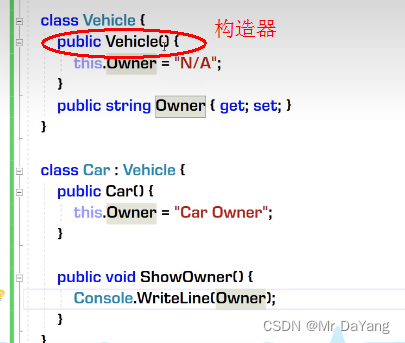
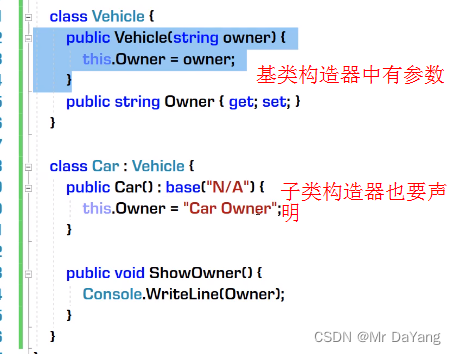
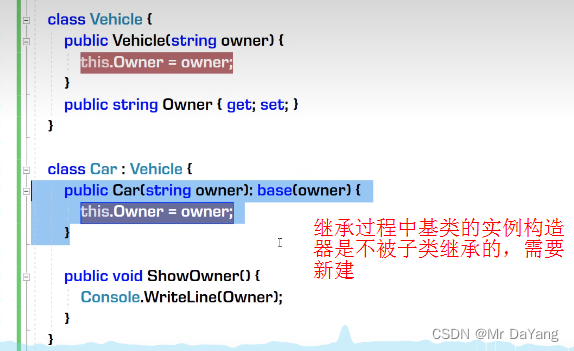
类成员的访问级别 低于类的访问级别
类定义默认是public ;类是属性默认为private
public 一个solution的多个项目都可访问
internal 在一个项目中的多个类中访问
private 只在当前类中使用,就算继承也不能访问
protected 修饰的类成员,此类成员只能被继承的类所调用
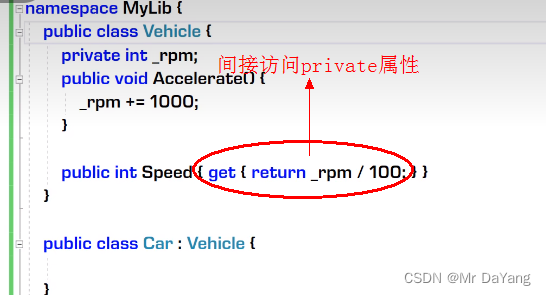
3类的继承
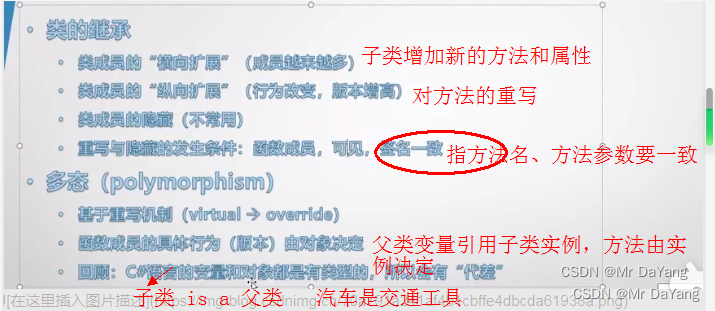
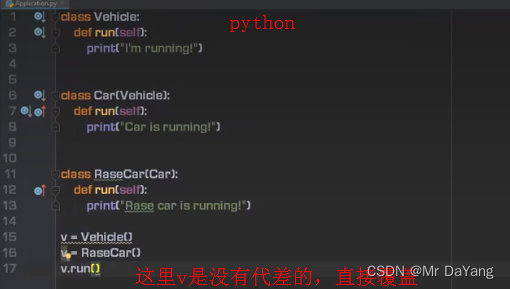
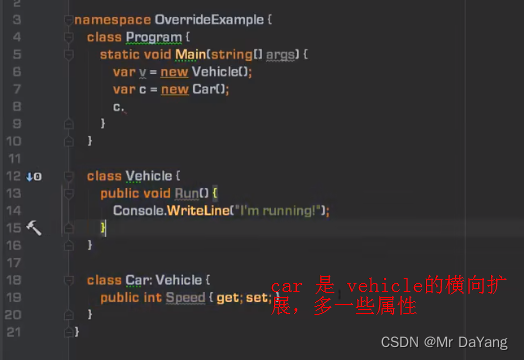
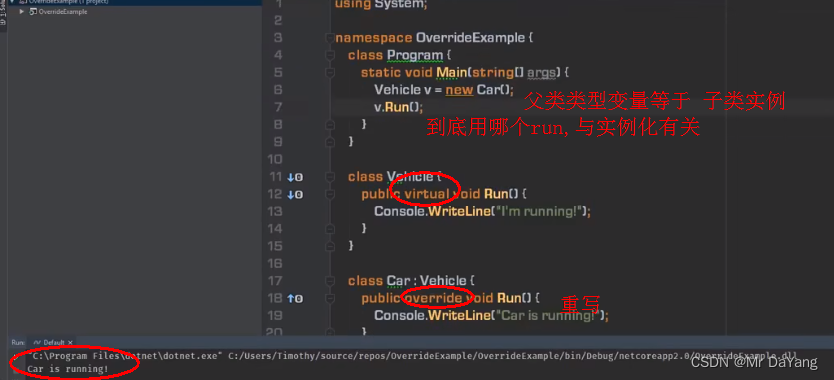
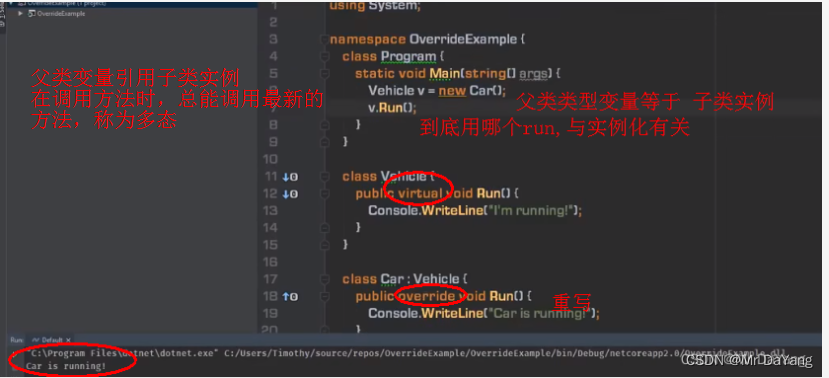
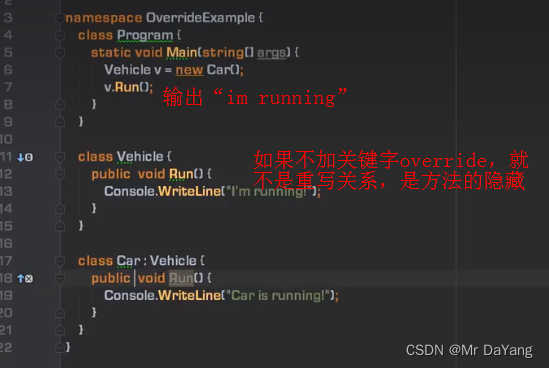

五、接口、抽象类
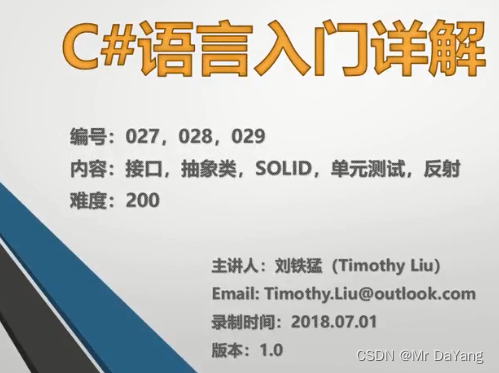
(人–接口–手机)多个人可分别使用不同款式手机
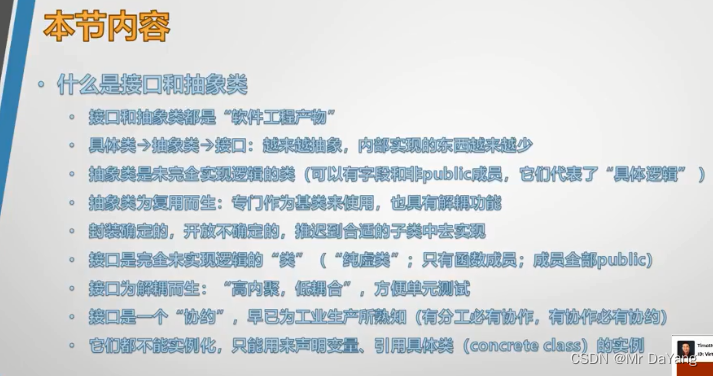
面向对象设计基本原则,通过设计的规则,让代码更为规范
abstract抽象类:函数成员未被完全实现的类(无方法体),不能实例化,抽象类只能作为基类,为子类服务,子类进行重写
abstract抽象类 一方面是用于子类继承,第二方法抽象类父类变量引用子类实例,代查
concrete具体类
开闭原则:在设计类的时候,把那些固定不变的方法,属性进行封装,把来回变动的采用抽象类,抽象方法供子类使用
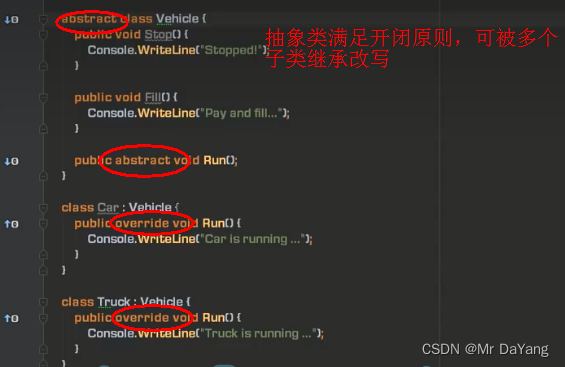
接口,抽象类,具体类


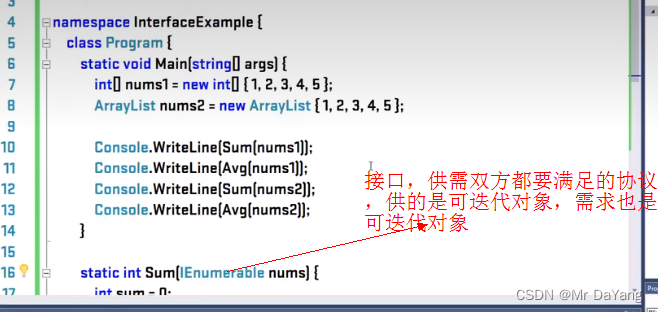
//耦合过多,car依赖于engine,engine出了问题 car也出问题,所以使用接口来解耦合
using System;
using System.Collections.Generic;
using System.Linq;
using System.Text;
using System.Threading.Tasks;
namespace ConsoleApp2
{
class Program
{
static void Main(string[] args)
{
var engine = new Engine();
var car = new Car(engine);
car.Run(3);
Console.WriteLine(car.Speed);
Console.ReadKey();
}
}
class Engine
{
public int RPM { get; private set; }
public void Work(int gas)
{
this.RPM = 1000 * gas;
}
}
class Car
{
private Engine _engine;
public Car(Engine engine)
{
_engine = engine;
}
public int Speed { get; private set; }
public void Run(int gas)
{
_engine.Work(gas);
this.Speed = _engine.RPM / 100;
}
}
}
//用接口来解耦合
using System;
using System.Collections.Generic;
using System.Linq;
using System.Text;
using System.Threading.Tasks;
namespace ConsoleApp2
{
class Program
{
static void Main(string[] args)
{
var user = new phoneuser(new nokia());
var user1 = new phoneuser(new erision());
user.usephone();
Console.Read();
}
}
class phoneuser
{
private iphone _phone;
public phoneuser( iphone phone)
{
_phone = phone;
}
public void usephone()
{
_phone.dail();
_phone.pickup();
_phone.send();
_phone.receive();
}
}
interface iphone
{
void dail();
void pickup();
void send();
void receive();
}
class nokia : iphone
{
public void dail()
{
Console.WriteLine("dailing........");
}
public void pickup()
{
Console.WriteLine("pickup......");
}
public void receive()
{
Console.WriteLine("receiving.......");
}
public void send()
{
Console.WriteLine("sending......");
}
}
class erision : iphone
{
public void dail()
{
Console.WriteLine("dailing-------");
}
public void pickup()
{
Console.WriteLine("pickup---------");
}
public void receive()
{
Console.WriteLine("receiving-------");
}
public void send()
{
Console.WriteLine("sending--------");
}
}
}
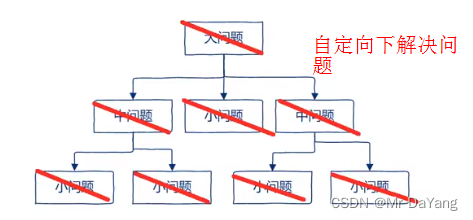

using System;
using System.Collections.Generic;
using System.Linq;
using System.Text;
using System.Threading.Tasks;
namespace ConsoleApp2
{
class Program
{
static void Main(string[] args)
{
var fan = new deskfan(new powersupply());
Console.WriteLine(fan.work());
Console.Read();
}
interface ipowersupply
{
int getpower();//定义一个返回值为int 的方法,无方法体
}
class powersupply:ipowersupply
{
public int getpower()
{
return 100;
}
}
class deskfan
{
private ipowersupply _powersupply;//由耦合函数powersupply换成接口函数 ipowersupply
public deskfan(ipowersupply powersupply)//由耦合函数powersupply换成接口函数 ipowersupply
{
_powersupply = powersupply;
}
public string work()
{
int power = _powersupply.getpower();
if (power < 0) { return "wont work"; }
else if (power < 100) { return "slow"; }
else if (power < 200) { return "work fine"; }
else { return "warning"; }
}
}
}
}
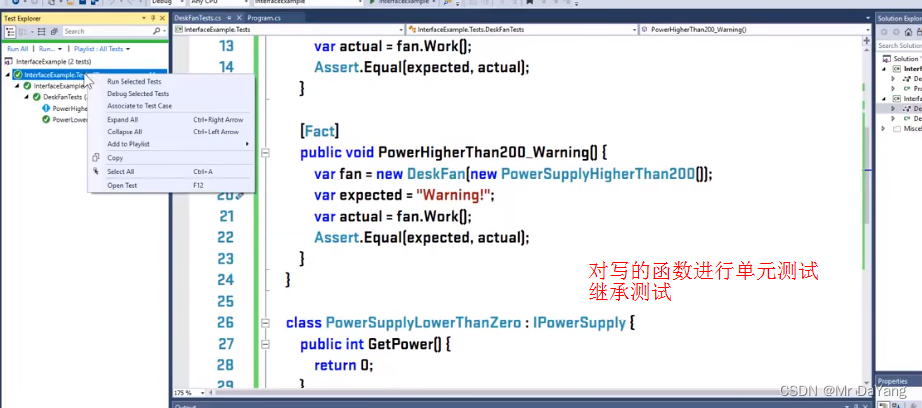

六、反射、依赖注入

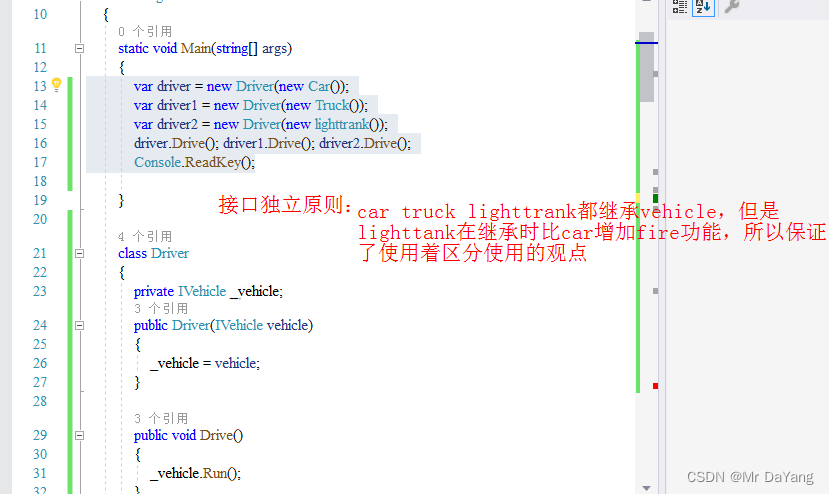
## 一个类多个可以多个接口,接口也可继承多个接口interface Itrank: IVehicle, Iweapon
class Program
{
static void Main(string[] args)
{
var driver = new Driver(new Car());
var driver1 = new Driver(new Truck());
var driver2 = new Driver(new lighttrank());
driver.Drive(); driver1.Drive(); driver2.Drive();
Console.ReadKey();
}
class Driver
{
private IVehicle _vehicle;
public Driver(IVehicle vehicle)
{
_vehicle = vehicle;
}
public void Drive()
{
_vehicle.Run();
}
}
interface IVehicle
{
void Run();
}
class Car : IVehicle
{
public void Run()
{
Console.WriteLine("car is running");
}
}
class Truck : IVehicle
{
public void Run()
{
Console.WriteLine("Truck is running");
}
}
interface Iweapon
{
void Fire();
}
interface Itrank: IVehicle, Iweapon
{
void Run();
void Fire();
}
## int[],ArrayList都继承了ICollection类,所以都可用于foreach的迭代
namespace ConsoleApp2
{
class Program
{
static void Main(string[] args)
{
int[] num1 = { 1, 2, 3, 4, 5 };
ArrayList num2 = new ArrayList { 1, 2, 3, 4, 5 };
Console.WriteLine(Sum(num1));
Console.WriteLine(Sum(num2));
Console.ReadKey();
}
static int Sum(ICollection nums)
{
int sum = 0;
foreach(var n in nums)
{
sum += (int)n;
}
return sum;
}
}
}
//接口的显示实现,c#独有
//void Ikill.Kill()//显示实现所有成员时, wk.Kill()是调不到此方法的
//Ikill ikill = wk; ikill.Kill(); 只有Ikill变量时,才能调用Kill()方法
namespace ConsoleApp2
{
class Program
{
static void Main(string[] args)
{
var wk = new Warmkill();
wk.Kill();
Ikill ikill = wk;
ikill.Kill();
Console.ReadKey();
}
interface Igentleman
{
void Love();
}
interface Ikill
{
void Kill();
}
class Warmkill : Igentleman, Ikill
{
public void Love()
{
Console.WriteLine("love you");
}
void Ikill.Kill()//显示实现所有成员
{
throw new NotImplementedException();
}
}
}
}
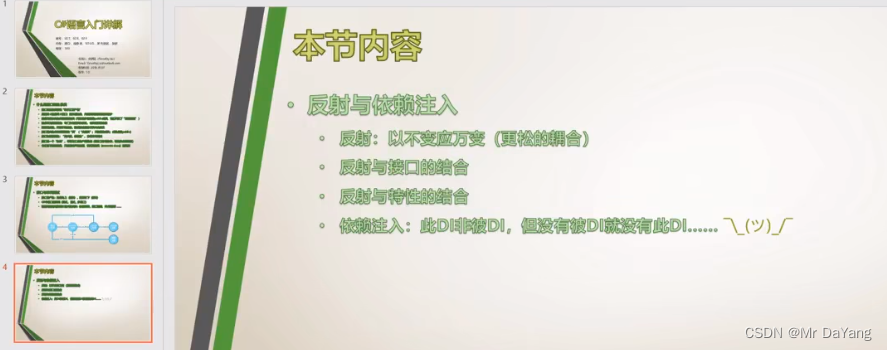
开发在编译代码的时候相当于静态代码,软件给用户使用时,处于dynamic状态,需要交互。开发可以枚举1000种方法来处理用户可能的操作,但太臃肿,也有可能覆盖不到,所以需要自己程序可以以不变应万变的能力,这个能力就是反射
反射可以不用new的情况,创建与类一个的类型,而且可访问其内部方法,相当于解耦合(用new创建时,后面要接类型,一有类型就有依赖)
普通反射
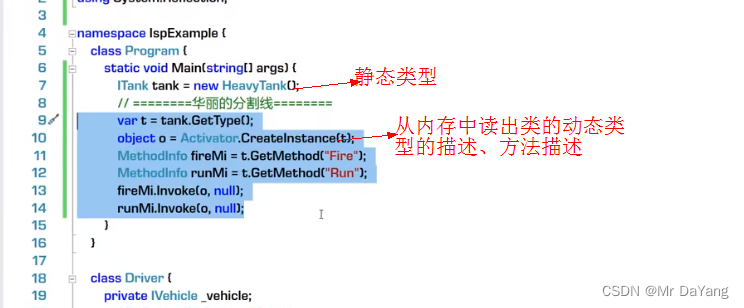

反射的用途1-依赖注入:用注册的动态类型,创建的实例,注入到Driver构造器中
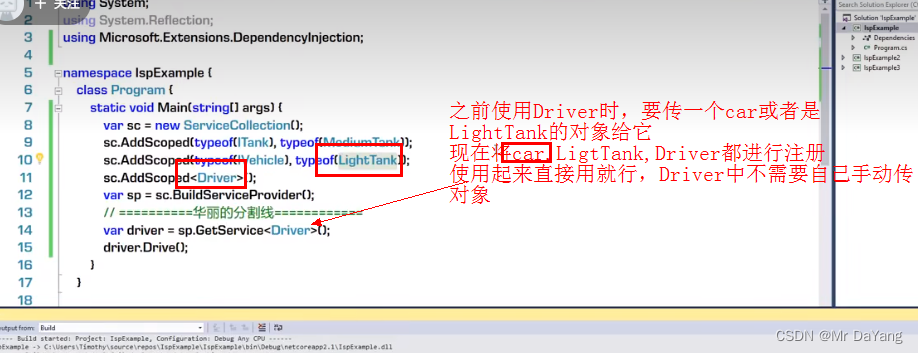
反射的用途2-利用反射追求更松的耦合
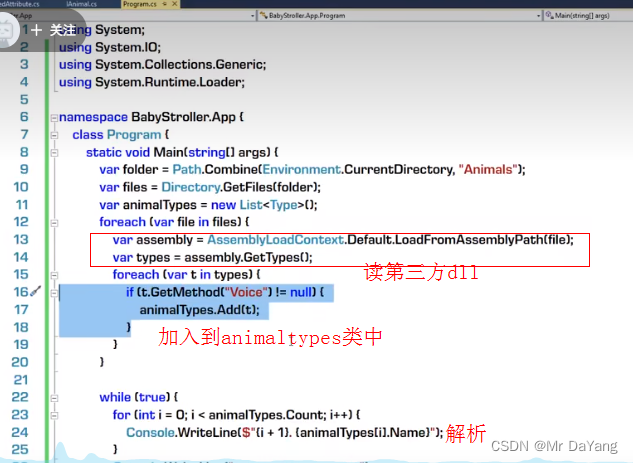

六、反射V2课程-Typeof
视频
反射就是使用代码动态的获取类型信息->Typeof
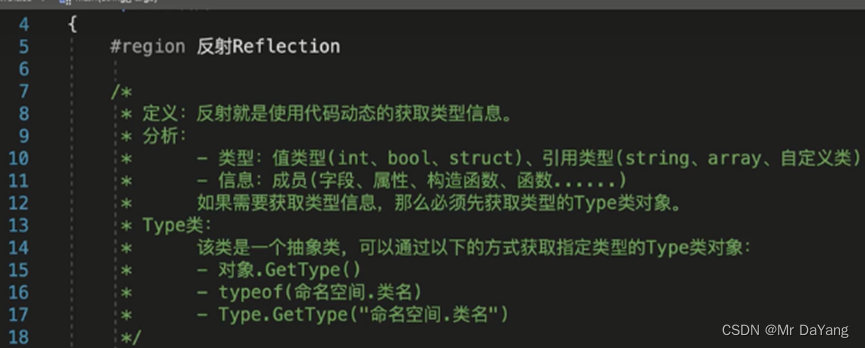

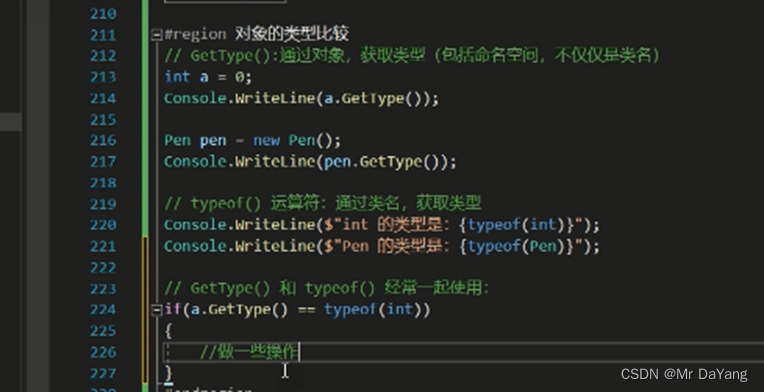
七、泛型V1课程(这里代码多练习)
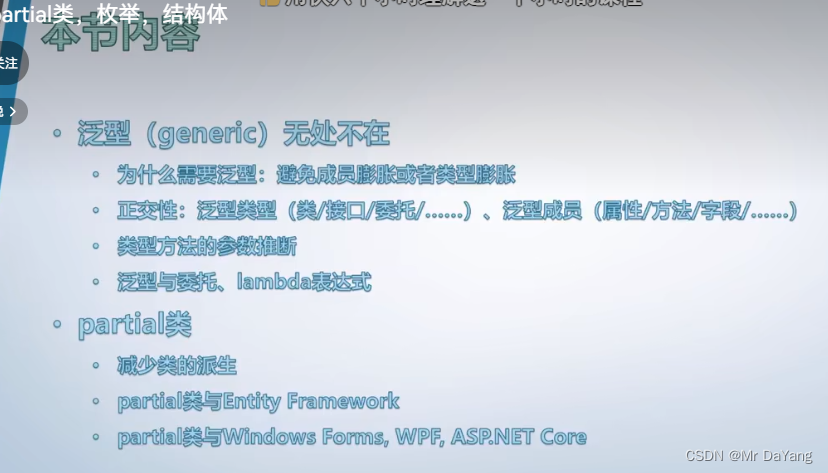
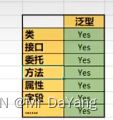
1.类型膨胀,1000种产品就会有1000种box,不好维护
using System;
using System.Collections;
using System.Collections.Generic;
using System.Linq;
using System.Text;
using System.Threading.Tasks;
namespace ConsoleApp2
{
class Program
{
static void Main(string[] args)
{
Apple apple = new Apple() { Color="red"};
AppleBox applebox = new AppleBox() { cargo = apple };
Console.WriteLine(applebox.cargo.Color);
Book book = new Book() { Name = "shuji" };
BookBox bookbox = new BookBox() { cargo = book };
Console.WriteLine(bookbox.cargo.Name);
Console.ReadKey();
}
class Apple
{
public string Color { get; set; }//Color属性
}
class AppleBox { public Apple cargo { get; set; } }//cargo属性
class Book
{
public string Name { get; set; }
}
class BookBox { public Book cargo { get; set; } }//cargo属性
}
}
2.成员膨胀:一个box类有多个属性,给不同的商品

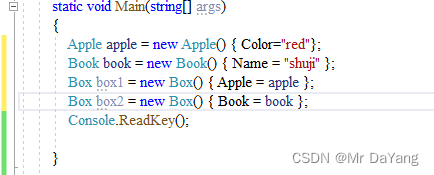
3.通过向box中传objecet对象,可以快速装箱,但读取箱中内容时,不好操作

namespace ConsoleApp2
{
class Program
{
static void Main(string[] args)
{
Apple apple = new Apple() { Color="red"};
Book book = new Book() { Name = "shuji" };
Box box1 = new Box() { cargo = apple };
Box box2 = new Box() { cargo = book };
Console.WriteLine(box1.cargo.Color);//此处已经将book对象转换成object对象,无法再获得book对象中属性
Console.WriteLine((box1.cargo as Apple)?.Color);//可类型转换
Console.ReadKey();
}
class Apple
{
public string Color { get; set; }//Color属性
}
class Book
{
public string Name { get; set; }
}
//成员膨胀,一个box中有多个属性,每次只使用其中的一个,当新商品来时,还得修改此类
class Box {
public Object cargo { get; set; }
}
}
}
4.使用泛型不会产生类型膨胀、成员膨胀
using System;
using System.Collections;
using System.Collections.Generic;
using System.Linq;
using System.Text;
using System.Threading.Tasks;
namespace ConsoleApp2
{
class Program
{
static void Main(string[] args)
{
Apple apple = new Apple() { Color="red"};
Book book = new Book() { Name = "shuji" };
//用泛型将box特化
Box<Apple> box1 = new Box<Apple>() { cargo = apple };
Box<Book> box2 = new Box<Book>() { cargo = book };
Console.WriteLine(box1.cargo.Color);
Console.WriteLine(box2.cargo.Name);
Console.ReadKey();
}
class Apple
{
public string Color { get; set; }//Color属性
}
class Book
{
public string Name { get; set; }
}
class Box<Tcargo> {
public Tcargo cargo{ get; set; }
}
}
}
5.泛型接口
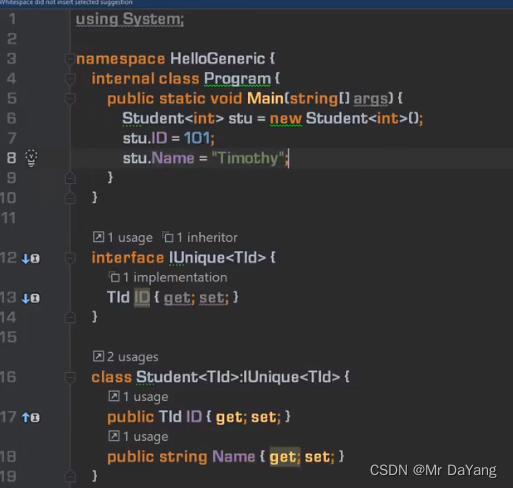
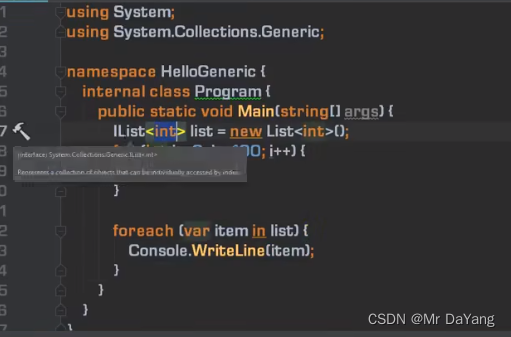
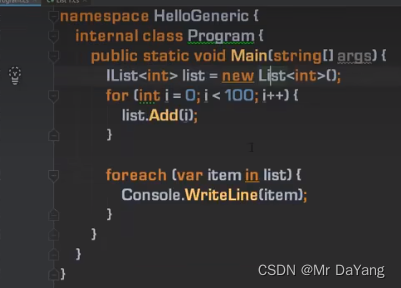
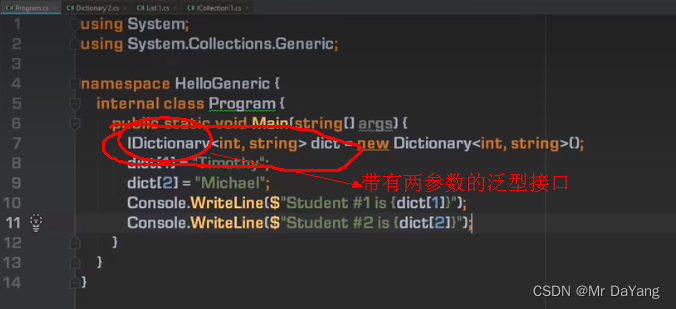
泛型方法
成员膨胀
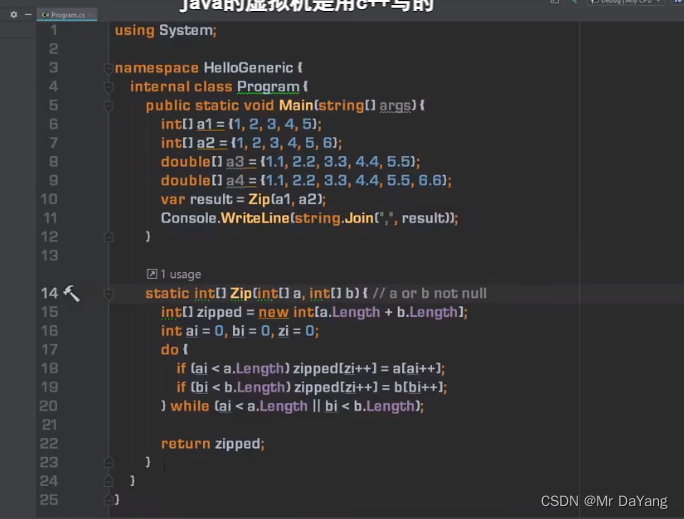
泛型方法(类型参数 加到zip方法后)
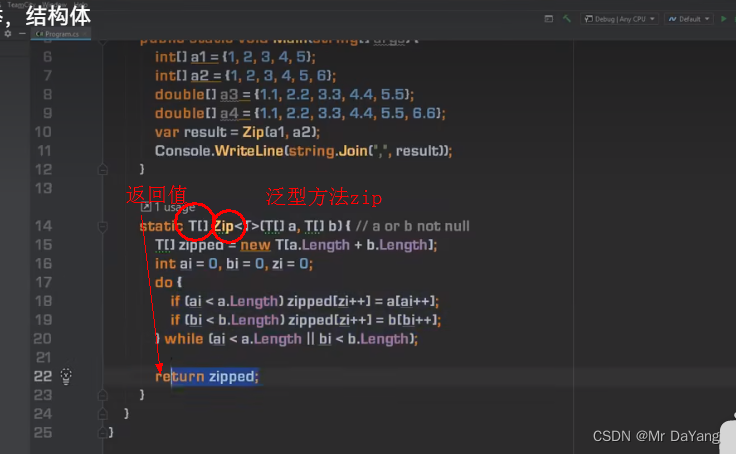
泛型委托
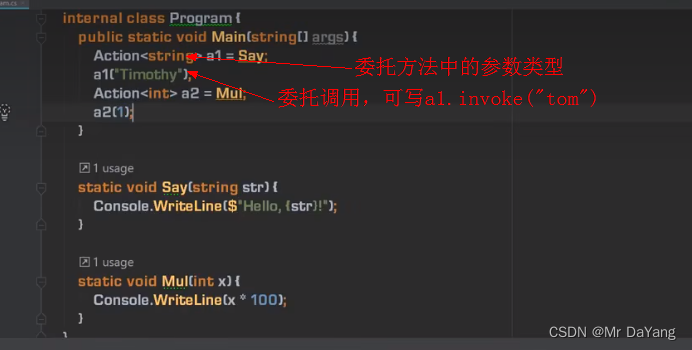




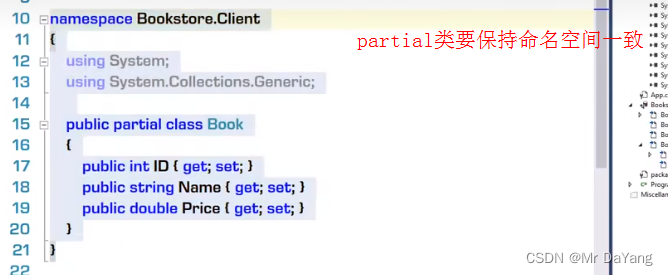
7.1枚举和结构体类型
结构体类型
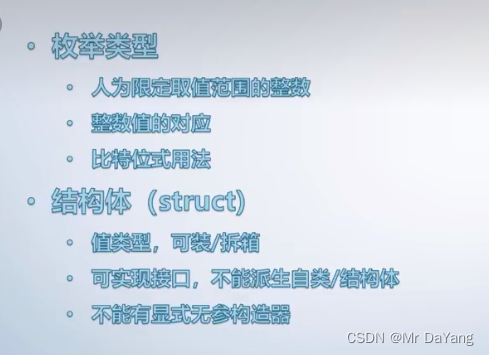
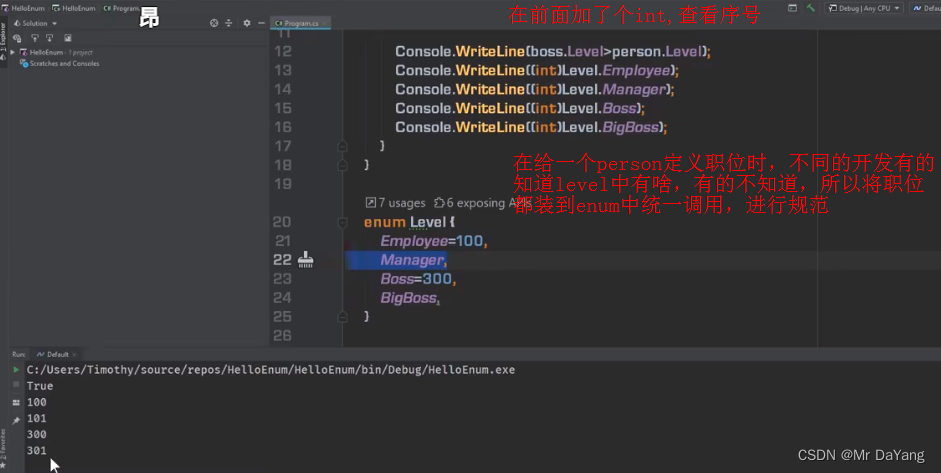
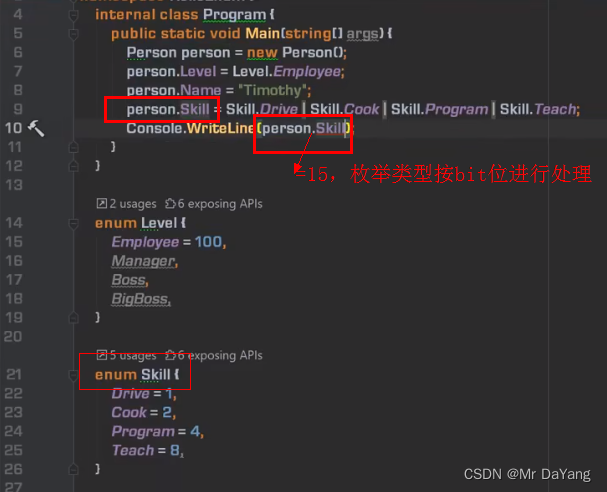
结构体类型是值类型,值类型:与值类型相关连的内存中存在的是此实例
值类型的copy: copy的是一个完整对象
变量类型的copy:是对同一个对象的引用(一份数据)
堆内存中的实例

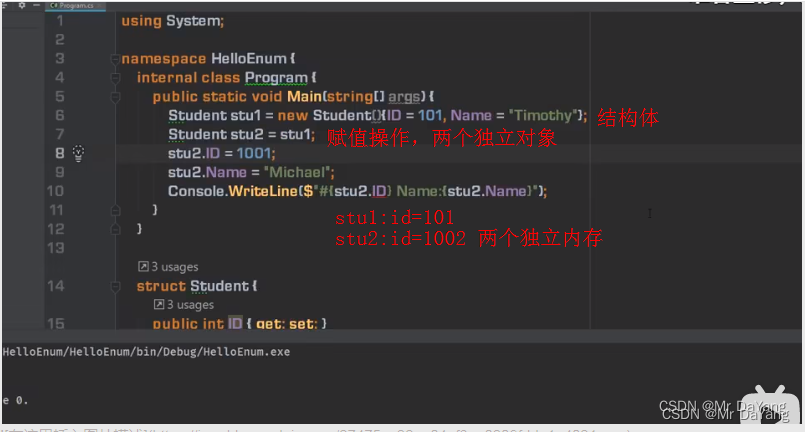
结构体不能由其他结构体类型、类类型派生而来,只能由interface来
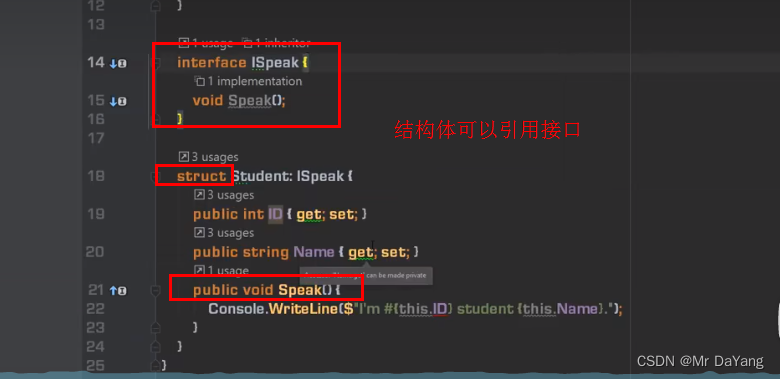
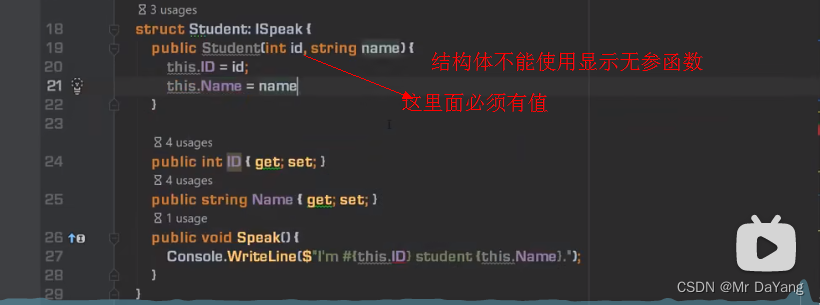
七、泛型V2课程
7.1泛型类、泛型方法的申明与特化


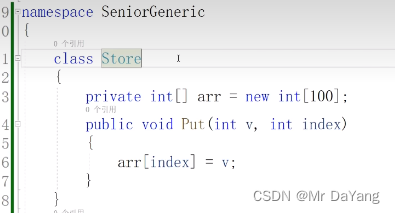

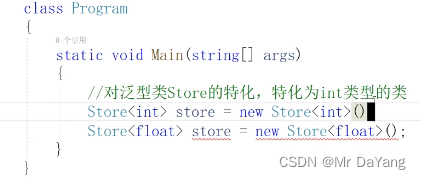
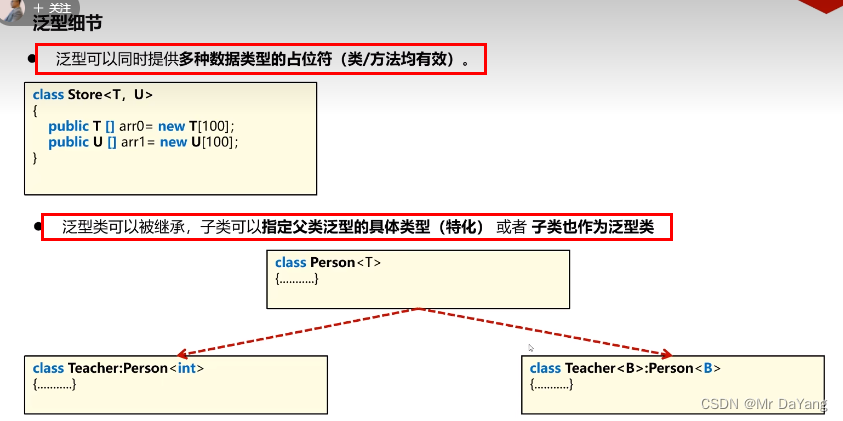
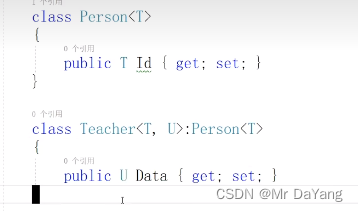
泛型特化后,得到int类型的ID float类型的data

泛型类、泛型方法的申明与特化
//泛型类、泛型方法:创建类、方法时,在类、方法名后面加上<T>占位符
store1<int> store = new store1<int>();//对泛型特化
StoreDouble1<int, float> a1 = new StoreDouble1<int, float>();
int m = 10; int n = 20;
Swap1<int>(ref m, ref n);
add1<int>(3, 4);
add1<float>(3.1f, 4.2f);
}
public static void Swap(ref int a, ref int b)
{
int temp = a;
a = b;
b = temp;
}
public static void Swap1<T>(ref T a, ref T b)
{
T temp = a;
a = b;
b = temp;
}
public static int add(int a, int b)
{
return a + b;
}
public static int add1<T>(T a, T b)
{
//return a + b;//传进来的特化类型不一定支持加法操作,如果a,b是int那是可以的,如果传进来的是class
dynamic da = a;//上面直接加的方法,c#在编译的时候就会报错,现在方法是编译时不检查,运行时检查
dynamic db = a;
return da + db;
}
}
class store
{
int[] arr = new int[100];
public void put(int v,int index)
{
arr[index] = v;
}
}
class store1<myt>
{
myt[] arr = new myt[100];
public void put(myt v, int index)
{
arr[index] = v;
}
}
class StoreDouble
{
public int[] Arr0 { get; set; }
public float[] Arr1 { get; set; }
}
class StoreDouble1<T1,T2>
{
public T1[] Arr0 { get; set; }
public T2[] Arr1 { get; set; }
}
7.2泛型约束


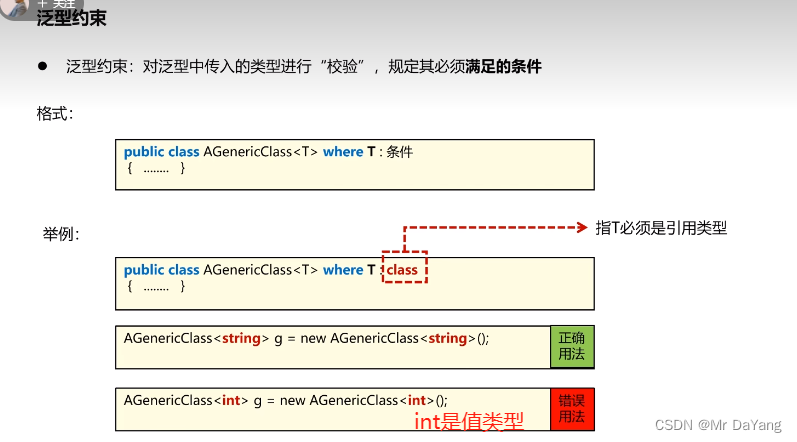
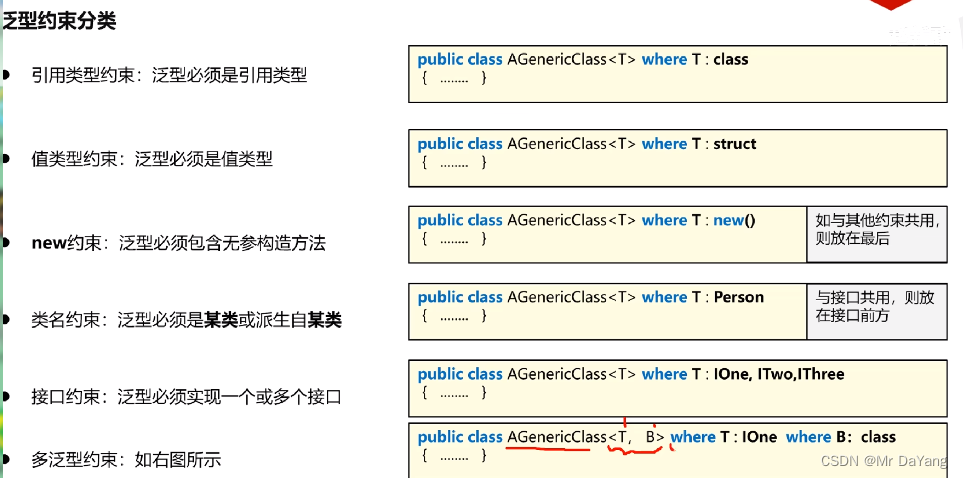

//1.class是引用类型约束,int是值类型
mygenericclass<int> m = new mygenericclass<int>();//报错
mygenericclass<string> m1 = new mygenericclass<string>();
mygenericclass1<int> m2 = new mygenericclass1<int>();
mygenericclass2<testnew> m3 = new mygenericclass2<testnew>();
mygenericclass2<testnew1> m33 = new mygenericclass2<testnew1>();//报错
mygenericclass4<person> m4 = new mygenericclass4<person>();//报错
mygenericclass5<tank> m5 = new mygenericclass5<tank>();
class mygenericclass<T> where T : class
{
}
class mygenericclass1<T> where T : struct
{
}
class testnew
{
public testnew() { }
}
class testnew1
{
public testnew1() { }
public testnew1(int a) { }
}
class mygenericclass2<T> where T : new()
{
}
class mygenericclass3<T> where T : class, new()
{
}
class mygenericclass4<T> where T : person
{
}
class person
{
}
class teacher : person
{
}
interface ifire
{
void fire();
}
interface irun
{
void run();
}
class tank : ifire, irun
{
public void fire() { }
public void run() { }
}
class mygenericclass5<T> where T : ifire
{
}
八、其他知识点
1.Marshal.SizeOf和sizeof的区别
参考1、参考2
在.NET中一般都是通过sizeof()或Marshal.SizeOf()来获取数据类型的大小
sizeof()在编译时获得一个数据类型的确定大小,并且被指定为一个常量。如果试图把它用在无效类型上则会出现编译错误
Marshal.SizeOf在运行时计算结构化数据类型的大小
看这些相同类型下,在.Net中被封送处理成非托管的数据类型时,原托管类型2个字节的Char计算成了Windows系统类型中的1个字节的SBYTE,而托管类型1个字节的Boolean计算成了Windows系统类型中的4个字节的BOOL。
1 Marshal.SizeOf<Boolean>(): 4
2 sizeof(Boolean): 1
3 Marshal.SizeOf<Char>(): 1
4 sizeof(Char): 2
2.Var关键字
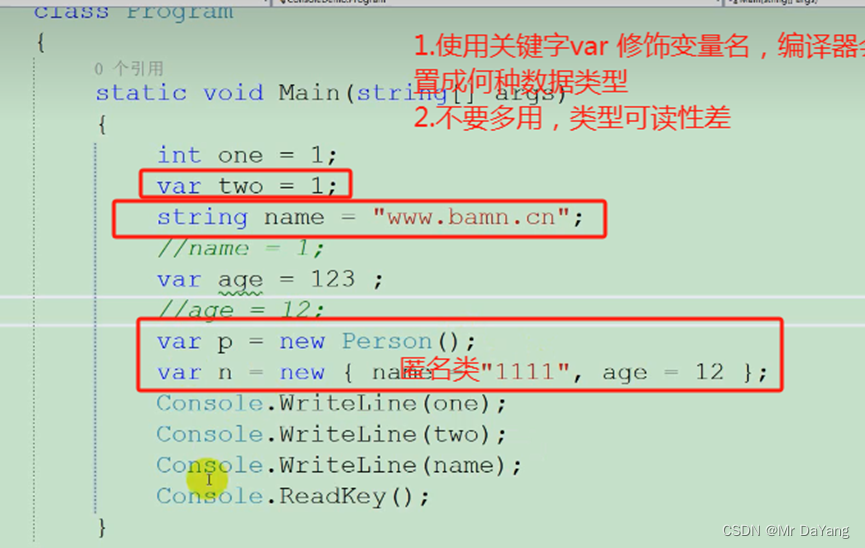
3.lambda表达式(必须配合委托和事件)
/*
1。
void dayin (string msg){
Console.WriteLine(msg);
}
//(string msg) => { Console.WriteLine(msg); };就是一个函数的缩写
//()括号中的参数就是后面lambda所需要的参数,与python中类似
2.单独lambda无法使用,必须配合委托和事件
一种是:
Action action1 = () => { Console.WriteLine(111); };
二种是: 将() => { Console.WriteLine(111)};当成一个委托,传给有需要的函数体
var respStrList = respList.Select(r => Convert.ToString(r, 2)).ToList();
values.ForEach(c => Console.WriteLine(Convert.ToBoolean(int.Parse(c.ToString()))));
*/
//1单独lambda无法使用,必须配合委托和事件
//无参\无返回lambda
Action action = () => Console.WriteLine(111);
Action action1 = () => { Console.WriteLine(111); };
action();
//2有参无返lambda
Action <string>action3 = (string msg) => { Console.WriteLine(msg); };
Action<string> action4 = msg => { Console.WriteLine(msg); };
action3("1111");
//3.有参有返
Func<int, int> func = x =>
{ return x + 1;
};
Func<int, int> func1 = x => x + 1; //x为输入值,后面x+1为返回值
Console.WriteLine(func(99));
//4lambda作为参数
int[] arr = { 68, 69, 63, 24, 883, 3 };
Console.WriteLine($"arr 数组中有{arr.Count(x => x % 2 == 1)}个奇数");
//5.闭包对象
class Test2
{
public Action<string?> CreateWrite()
{
string msg = "";// msg就是闭包的私有状态,只能本函数使用
return (string? info) =>
{
msg = info ?? msg;
Console.WriteLine(msg);
}
}
}


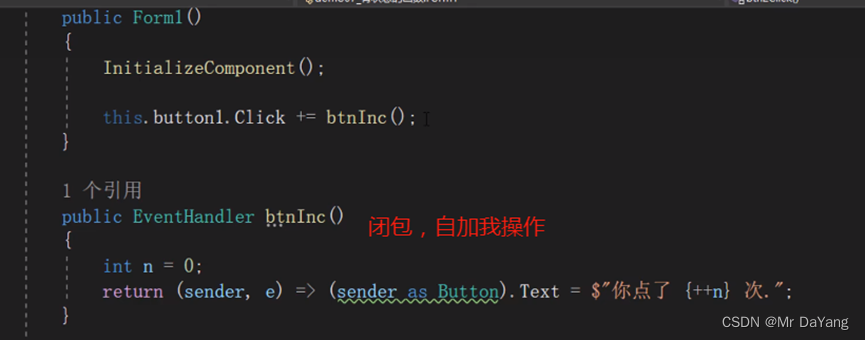
1.C#垃圾回收
八、核心代码汇总
using System;
using System.Collections.Generic;
using System.ComponentModel;
using System.Data;
using System.Drawing;
using System.Linq;
using System.Reflection;
using System.Text;
using System.Threading;
using System.Threading.Tasks;
using System.Timers;
using System.Windows.Forms;
namespace Core_knowledge
{
public partial class Form1 : Form
{
//1类
//1.1属性方法定义
int a01 = 3;
public double Price { get; set; }
private void dosomething(string name)
{
Console.WriteLine($"[****Dosomething {name} start: 线程号:({Thread.CurrentThread.ManagedThreadId.ToString("00")})---{System.DateTime.Now.ToString("yyyy-MM-dd HH:mm:ss:fff")}*******]");
long result = 0;
for (int i = 0; i < 10000000; i++)
{
result += i;
}
Thread.Sleep(2000);
Console.WriteLine($"[****Dosomething {name} end: 线程号:({Thread.CurrentThread.ManagedThreadId.ToString("00")})---{System.DateTime.Now.ToString("yyyy-MM-dd HH:mm:ss:fff")}{result}*******]");
}
//1.2默认构造器 Student()是将数值型变成0,其他类型设置为null
Student stu = new Student();
//1.3构造器看着像方法,名子和类一样,有构造器后,引用创建对象时要传参否则报错-见class Student
Student stu2 = new Student(5, "timo");
//1.4初始化器{id=1,name="timothy" }
Student stu1 = new Student() { id = 1, name = "timothy" };
//1.5 析构器 ~Student() 函数在执行完后,说明这个对象没人用了就要释放,这里就会调用析构器,这里面可以写内存释放的代码
//1.6反射
/*
Type tt = typeof(Student);
object o = Activator.CreateInstance(tt, 15, "sss");
Student stu5 = o as Student;
Console.WriteLine(stu5.Name);*/
//1.7横向扩展对类成员的扩充,纵向扩展对类成员的重写
//1.8父类类型变量引用 子类类型实例 子类 is a 父类 汽车是车
public void s()
{
Vehicle v = new Car();//到底是哪个run,与实例化有关,谁被new,谁的被执行,这里是car running
v.run();
}
//1.9枚举-在定义一个person职位时,有人知道person有多少个level,有人不知道,所以放到enum中统一管理
public void meiju()
{
Console.WriteLine((int)Level.employee);
}
//1.10.见struct Student1 : ISpeak -结构体类型是值类型,值类型:与值类型相关连的内存中存在的是此实例
/*值类型的copy: copy的是一个完整对象
变量类型的copy:是对同一个对象的引用(一份数据) 堆内存中的实例
结构体不能由其他结构体类型、类类型派生而来,只能由interface来
*/
//2 IF_FOR_SWITCH
public void IF_FOR_SWITCH_foreach()
{
for (int c = 0; c < 5; c++)
{
int k = c;
Task.Run(
() =>
{
Thread.Sleep(100);
Console.WriteLine($"k={k}, i={c}");
}
);
}
int i = 0;
if (i > 10)
{
Console.WriteLine(1);
}
else if (i > 0 && i < 10)
{
Console.WriteLine(2);
}
else
{
Console.WriteLine(3);
}
switch (i)
{
case 1:
Console.WriteLine(1);
break;
case 2:
Console.WriteLine(1);
break;
default:
Console.WriteLine(1);
break;
}
int[] p = new int[] { 1, 2, 3 };
foreach (int p1 in p)
{
}
}
//3常用代码
public void Commoncode()
{
//数据类型
int q = 2;
int[] a = new int[6];
int[] b = new int[3] { 1, 2, 3 };
Console.WriteLine(a[1].ToString());
int[] c = new int[] { 'a', 2, 3 };
List<string> a1 = new List<string>() { "a", "b" };
Console.WriteLine(a1[1].ToString());
//List<Person> p = new List<Person>();
//p.Add(new Person() { });
a1.Add("112");
a[0] = 4;
a1.Insert(0, "3");
a1.RemoveAt(0);
a1.Remove("a");
a1.Clear();
Dictionary<int, string> d = new Dictionary<int, string> { //对象初始化器
{ 2,"333"},{4,"555"}
};
MessageBox.Show(c[0].ToString());
MessageBox.Show("1");
Console.WriteLine($"[------------主线程start: 线程号:({Thread.CurrentThread.ManagedThreadId.ToString("00")})---{System.DateTime.Now.ToString("yyyy-MM-dd HH:mm:ss:fff")}-----]");
}
//4Trycatch()
public void Trycatch()
{
try
{
if (2 > 1)
{
throw new Exception(string.Format($"执行失败"));
}
}
catch (Exception ex)
{
Console.WriteLine(ex.Message);
}
try
{
float a = 3;
double b = 3.2;
}
catch (AggregateException aex)
{
foreach (var item in aex.InnerExceptions)
{
Console.WriteLine(item.Message);
}
}
catch (Exception ex)
{
Console.WriteLine(ex.Message);
}
}
//5委托使用-委托相当于一个指针,可以指定任意方法,就可以实现方法调方法。
public void action()
{
//5.1.无返回值委托-Action委托
Calculator calculator = new Calculator();
Action action = new Action(calculator.Report);//Action: 方法是void,并且无参数
action.Invoke();//委托调用
Action<string> action = this.dosomething;//委托带参数
Action action1 = () => this.dosomething("CC");//委托不带参数
Logger logger = new Logger();
Action<Product> log = new Action<Product>(logger.Log);
//5.2.有返回值委托-Func委托
//<第一个int为返回值, 第二三个int为函数输入>
Func<int, int, int> func1 = new Func<int, int, int>(calculator.Add);//Func :方法是有返回,有参数
int x = 100;
int y = 200;
int z = 0;
int c = 0;
z = func1.Invoke(x, y);//委托调用
func1(x, y);//模仿c中函数指针的书写格式
//Product为委托的返回类型 ,func1为委托名 委托的返回值类型是Product,委托的函数名称=prodectFactory.MakePiza
//Func<Product> func1 = new Func<Product>(prodectFactory.MakePiza);
//5.3.委托简单使用-delegate自定义委托
//public delegate int Calc(int x, int y);//自定义委托是个类,格式要与委托函数一致
Calc calc1 = new Calc(calculator.Add);//委托实例化
c = calc1.Invoke(x, y);
//5.4.实现目的:方法中调用方法
//模板方法:方法中 输入 用委托类型参数封装的方法-具体看WrapProduct方法
//回调方法:方法中 在调用 用委托类型参数封装的方法 时,有条件判断-具体看WrapProduct方法
WrapFactory wrapFactory = new WrapFactory();
ProdectFactory prodectFactory = new ProdectFactory();
Action<Product> log1 = new Action<Product>(logger.Log);
Func<Product> func2 = new Func<Product>(prodectFactory.MakePiza);
//用委托将方法进行封装,然后将这个委托传到B方法中,在B方法中对委托进行调用,实现了方法中调用方的目的
//同时委托相当于一个指针,可以封装各式各样的方法,那么B方法也就可以调用任意方法
Box box1 = wrapFactory.WrapProduct(func2, log1);
//5.5.多播委托\异步委托调用
//直接同步调用:使用方法名
Student stu1 = new Student() { id = 1, pencolor = ConsoleColor.Yellow };
Student stu2 = new Student() { id = 1, pencolor = ConsoleColor.Yellow };
Student stu3 = new Student() { id = 1, pencolor = ConsoleColor.Yellow };
stu1.dohomework();
//5.6.间接同步调用:使用单播、多播委托invoke
Action action1 = new Action(stu1.dohomework);
Action action2 = new Action(stu2.dohomework);
Action action3 = new Action(stu3.dohomework);
action1.Invoke();//单播委托
action1 += action2;//多播委托
action1 += action3;
action1.Invoke();
//5.7.隐式异步调用:使用委托的begininvoke
Action action4 = new Action(stu1.dohomework);
action4.BeginInvoke(null, null);//第一个null为执行完线程后的回调函数
//5.8. 显示异步调用:使用thread或task
Thread thread1 = new Thread(new ThreadStart(stu1.dohomework));
thread1.Start();
}
//6.事件
public void shijian()
{
System.Timers.Timer timer = new System.Timers.Timer(); // timer.Elapsed事件的拥有者Timer
timer.Interval = 3000;
Boy boy = new Boy(); //事件的订阅者
Girl girl = new Girl();
// 订阅者的处理器 +=表示订阅 拿方法订阅一个事件时,它们要遵守约定:约定就是委托类型
// timer.Elapsed的类型就是 public delegate void ElapsedEventHandler(object sender, ElapsedEventArgs e);
// 所以使用alt+enter自动按照委托形式对boy.Action进行方法创建
timer.Elapsed += boy.Action; //timer.Elapsed 为事件,boy.Action为事件处理器
timer.Elapsed += girl.Action; //一个事件两个订阅者
timer.Start();
Console.ReadLine();
//三星:事件的拥有者是响应者的成员,见class Myform : Form
//事件自定义-可再找之间代码学习,学习过
}
//7.抽象类
//abstract抽象类-不能实例化:函数成员未被完全实现的类(无方法体),抽象类只能作为基类,为子类服务,子类进行重写 见-abstract class vehicle1
//abstract抽象类 一方面是用于子类继承,第二方法抽象类父类变量引用子类实例,代查
//concrete具体类
//8.接口-纯虚类-不能实例化 见class phoneuser、interface vehiclebase
public void jiekou() //(人–接口–(苹果手机,华为手机))多个人可分别使用不同款式手机
{
var user = new phoneuser(new nokia());
var user1 = new phoneuser(new erision());
user.usephone();
Console.Read();
//一个类多个可以多个接口,接口也可继承多个接口interface Itrank: IVehicle, Iweapon
var driver = new Driver(new Car1());
var driver1 = new Driver(new Truck());
driver.Drive(); driver1.Drive();
}
//9.反射的用途
//9.1.反射的用途-依赖注入: 用注册的动态类型,创建的实例,注入到Driver构造器中
//开发在编译代码的时候相当于静态代码,软件给用户使用时,处于dynamic状态,需要交互。开发可以枚举1000种方法来处理用户可能的操作,但太臃肿,也有可能覆盖不到,所以需要自己程序可以以不变应万变的能力,这个能力就是反射
//反射可以不用new的情况,创建与类一个的类型,而且可访问其内部方法,相当于解耦合(用new创建时,后面要接类型,一有类型就有依赖)
/*
public void fanshe()
{
Tank tank = new Tank();
var t = tank.GetType();
object o=Activator.CreateInstance(t);
MethodInfo fire= t.GetMethod("fire");
fire.Invoke(o, null);
}
public void zhuru()
{
var sc = new ServiceCollection();//建立容器
sc.AddScoped(typeof(ITank), typeof(MdediumTank));//typeof()获取类的动态参数,在容器中进行注册
var sp = sc.BuildServiceProvider();//建立服务
ITank tank=sp.GetService<ITank>();//使用
tank.fire();
tank.run();
}
//9.2反射的用途-利用反射追求更松的耦合--读第三方dll
EnvironmentVariableTarget assembly = AssemblyLoadContext.Defalut.Load....
*/
//10泛型
/*
1.类型膨胀,1000种产品就会有1000种box,不好维护 2.成员膨胀:一个box类有多个属性,给不同的商品
*/
List<int> list = new List<int>();//参考泛型写法:前面List类型中只能存放int类的变量
public void fanxing()
{
Apple apple = new Apple() { Color = "red" };
Book book = new Book() { Name = "shuji" };
//用泛型将box特化
Box<Apple> box1 = new Box<Apple> { cargo = apple };
Box<Book> box2 = new Box<Book>() { cargo = book };
Console.WriteLine(box1.cargo.Color);
Console.WriteLine(box2.cargo.Name);
//泛型接口
Student<int> stu = new Student<int>();
stu.ID = 101;
stu.Name = "asd";
}
//11.partial类 相当于一个类被切分成多个部分进行存放-要保持命名空间一致(namespace)
public Form1()
{
InitializeComponent();
}
private void button1_Click(object sender, EventArgs e)
{
//Trycatch();
//Commoncode();
//shijian();
//Myform myform = new Myform();
//myform.ShowDialog();
fanxing();
}
}
class Calculator
{
public void Report()
{
Console.WriteLine("i have 3 methods");
}
public int Add(int a, int b)
{
int result = a + b;
return result;
}
public int Sub(int a, int b)
{
int result = a - b;
return result;
}
}
public delegate int Calc(int x, int y);//自定义委托是个类,格式要与委托函数一致
class Logger
{
public void Log(Product product)
{
Console.WriteLine("Product '{0}' created at {1},price is {2}", product.Name, DateTime.UtcNow, product.Price);
}
}
class Product
{
public string Name { get; set; } //类属性是string
public double Price { get; set; }
}
class Box
{
public Product product { get; set; }//类属性是一个类
}
class WrapFactory
{
//WrapProduct 委托的模板方法,Box方法的返回值
//委托模板方法的输入是委托函数 Func<Product> getProduct
public Box WrapProduct(Func<Product> getProduct, Action<Product> logCallback)
{
Box box = new Box();
Product product = getProduct.Invoke();
if (product.Price > 50)
{
logCallback(product);
}
box.product = product;
return box;
}
}
class ProdectFactory
{
public Product MakePiza()
{
Product product = new Product();
product.Name = "Pizza";
product.Price = 12;
return product;
}
public Product Makecar()
{
Product product = new Product();
product.Name = "car";
product.Price = 100;
return product;
}
}
class Student
{
public Student()//创建一个空的,给不传参使用,否则会报错
{
}
public Student(int Id, string Name)//构造器看着像方法,名子和类一样,有构造器后,引用创建对象时要传参否则报错
{
this.id = Id;
this.name = Name;
}
public static int Amount { get; set; }
static Student() { Amount = 100; }
~Student()
{
Console.WriteLine("bye bye");
}
public int id { get; set; }
public string name { get; set; }
public ConsoleColor pencolor { get; set; }
public void dohomework()
{
for (int i = 0; i < 5; i++)
{
Console.ForegroundColor = this.pencolor;
Console.WriteLine("student{0} doing homework {1} hours", this.id, i);
Thread.Sleep(1000);
}
}
}
class Boy
{
internal void Action(object sender, ElapsedEventArgs e)
{
Console.WriteLine("Jump");
}
}
class Girl
{
internal void Action(object sender, ElapsedEventArgs e)
{
Console.WriteLine("sing");
}
}
//三星:事件的拥有者是响应者的成员
class Myform : Form
{
private TextBox textBox;
private Button button;//form的字段成员,拥有者
public Myform()
{
this.button = new Button();
this.button.Location = new System.Drawing.Point(276, 176);
this.button.Size = new System.Drawing.Size(75, 23);
this.button.Text = "sss";
this.textBox = new TextBox();
this.textBox.Location = new System.Drawing.Point(176, 176);
this.textBox.Size = new System.Drawing.Size(120, 23);
this.Controls.Add(this.button);
this.Controls.Add(this.textBox);
this.button.Click += this.buttonCllicked; //form =响应者
}
private void buttonCllicked(object sender, EventArgs e)
{
this.textBox.Text = "hello world```````````````````````````";
}
}
class Vehicle
{
public Vehicle()
{
this.Owner = "NA";
}
public Vehicle(string owner)
{
this.Owner = owner;
}
public virtual void run()
{
Console.WriteLine("vehicle is running");
}
public string Owner { get; set; }
}
class Car : Vehicle
{
public Car()
{
this.Owner = "car";
}
//public Car() :base("NA")//基类构造器中有参数,子类构造器也要声明
//{
// this.Owner ="car owner";
//}
public void doing()
{
Console.WriteLine("222");
}
public override void run()
{
Console.WriteLine("car is running");
}
}
abstract class vehicle1
{
public void fill()//
{
Console.WriteLine("111");
}
public abstract void run1();//抽象方法
}
class car1 : vehicle1
{
public override void run1()
{
Console.WriteLine("111");
}
}
interface vehiclebase
{
void stop();
void fill();
}
class phoneuser
{
private iphone _phone;
public phoneuser(iphone phone)
{
_phone = phone;
}
public void usephone()
{
_phone.dail();
_phone.pickup();
_phone.send();
_phone.receive();
}
}
interface iphone
{
void dail();
void pickup();
void send();
void receive();
}
class nokia : iphone
{
public void dail()
{
Console.WriteLine("dailing........");
}
public void pickup()
{
Console.WriteLine("pickup......");
}
public void receive()
{
Console.WriteLine("receiving.......");
}
public void send()
{
Console.WriteLine("sending......");
}
}
class erision : iphone
{
public void dail()
{
Console.WriteLine("dailing-------");
}
public void pickup()
{
Console.WriteLine("pickup---------");
}
public void receive()
{
Console.WriteLine("receiving-------");
}
public void send()
{
Console.WriteLine("sending--------");
}
}
class Driver
{
private IVehicle _vehicle;
public Driver(IVehicle vehicle)
{
_vehicle = vehicle;
}
public void Drive()
{
_vehicle.Run();
}
}
interface IVehicle
{
void Run();
}
class Car1 : IVehicle
{
public void Run()
{
Console.WriteLine("car is running");
}
}
class Truck : IVehicle
{
public void Run()
{
Console.WriteLine("Truck is running");
}
}
interface Iweapon
{
void Fire();
}
interface Itrank : IVehicle, Iweapon
{
void Run();
void Fire();
}
class Tank{
void run()
{
}
void fire() { }
}
class Book
{
public string Name { get; set; }
}
class Apple
{
public string Color { get; set; }
}
class Box<Tcargo>
{
public Tcargo cargo { get; set; }
}
interface IUnique<TId>
{
TId ID { get; set; }
}
class Student<TId>: IUnique<TId>
{
public TId ID { get; set; }
public string Name { get; set; }
}
enum Level
{
employee=100,
manager,
boss=300,
}
interface ISpeak
{
void speak();
}
struct Student1 : ISpeak
{
public Student1(int id )//结构体不能使用显示无参函数,这里面必须有值
{
this.ID = id;
}
public int ID { get; set; }
public void speak()
{
Console.WriteLine("234");
}
}
}
数据类型
九、C#小功能
1.将dataGridView1表格中的数据以BinaryWriter方式写到本地
BinaryWriter是不知道哪些数据是标记数组大小的,哪些是实际数据,完全靠写代码的人自己定义,然后按照相同的规则去读出对应的数据
参考
using System;
using System.Collections.Generic;
using System.IO;
using System.Linq;
using System.Text;
using System.Threading.Tasks;
namespace ConsoleApp4
{
class Program
{
static void Main(string[] args)
{
string Path = "C:\\Users\\Administrator\\Desktop\\00\\c.txt";;
using (BinaryWriter binaryWriter = new BinaryWriter(File.Open(Path, FileMode.Create)))
{
int[] A = new int[] { 11,22,33};
int[] B = new int[] { 44, 55, };
// 写入数组A的长度和元素
int lengthA = A.Length;
binaryWriter.Write(lengthA);
foreach (int element in A)
{
binaryWriter.Write(element);
}
// 写入数组B的长度和元素
int lengthB = B.Length;
binaryWriter.Write(lengthB);
foreach (int element in B)
{
binaryWriter.Write(element);
}
Console.WriteLine("数据已经写完");
}
Console.ReadKey();
using (BinaryReader bw = new BinaryReader(File.Open(Path, FileMode.Open)))
{
Console.WriteLine("开始读数据---");
int length1=bw.ReadInt32();
int[] array1 = new int[length1];
for (int i = 0; i < length1; i++)
{
array1[i] =bw.ReadInt32(); // 读取数组中的每个整数值
}
int length2 = bw.ReadInt32();
int[] array2 = new int[length2];
for (int i = 0; i < length2; i++)
{
array2[i] = bw.ReadInt32(); // 读取数组中的每个整数值
}
Console.ReadKey();
}
}
}
}
private void 保存配置ToolStripMenuItem_Click(object sender, EventArgs e)
{
string path = "";
SaveFileDialog saveFileDialog = new SaveFileDialog();
//FolderBrowserDialog folder = new FolderBrowserDialog();
saveFileDialog.Title = "选择保存目录";
saveFileDialog.Filter = "bin文件(*.bins)|*.bin";
//saveFileDialog.Filter = "Text Files (*.txt) |*.txt| All Files (*.*)|*.*";
saveFileDialog.FileName = "序列配置";
saveFileDialog.InitialDirectory = "C:\\Users\\Administrator\\Desktop\\00";//chushi lujing
if (saveFileDialog.ShowDialog() == DialogResult.OK)
{
path = saveFileDialog.FileName;
//Console.WriteLine(path);
//path += "\\datagrid.bin";
using (BinaryWriter bw = new BinaryWriter(File.Open(path, FileMode.Create)))
{
bw.Write(dataGridView1.Columns.Count);
bw.Write(dataGridView1.Rows.Count);
//Console.WriteLine("---" + dataGridView1.Columns.Count + "----"+ dataGridView1.Rows.Count);
foreach (DataGridViewRow dgvR in dataGridView1.Rows)
{
for (int j = 0; j < dataGridView1.Columns.Count; ++j)
{
object val = dgvR.Cells[j].Value;
if (val == null)
{
bw.Write(false);
bw.Write(false);
}
else
{
bw.Write(true);
bw.Write(val.ToString());
//通过true,false将数据隔离,真实情况就是发送数据 true PLC true 22 true 33
//数据读取时先读true然后读“发送数据”,最终就是“发送数据,PLC,22,33”
//Console.WriteLine("---" + val.ToString() + "----");
}
}
}
}
}
else { return; }
}
private void 导入配置ToolStripMenuItem_Click(object sender, EventArgs e)
{
string file = "C:\\Users\\INOVANCE\\Desktop\\datagrid.bin";
OpenFileDialog dialog = new OpenFileDialog();
dialog.Title = "请选择文件";
dialog.InitialDirectory = "D://";
dialog.Filter = "bin文件(*.bin)|*.bin";
if (dialog.ShowDialog() == DialogResult.OK)
{
file = dialog.FileName;
dataGridView1.Rows.Clear();
using (BinaryReader bw = new BinaryReader(File.Open(file, FileMode.Open)))
{
int n = bw.ReadInt32();
int m = bw.ReadInt32();
Console.WriteLine("---" + n + "----"+m);
for (int i = 0; i < m - 1; ++i)
{
dataGridView1.Rows.Add();
for (int j = 0; j < n; ++j)
{
if (bw.ReadBoolean())
{
string s = bw.ReadString();
dataGridView1.Rows[i].Cells[j].Value = s;
}
else {
bool b=bw.ReadBoolean();
// Console.WriteLine(b);
}
}
}
}
}
}
2.类库生成dll并导入使用
3.动态链接库 vs 静态链接库
4.dll隐式调用vs显式调用
